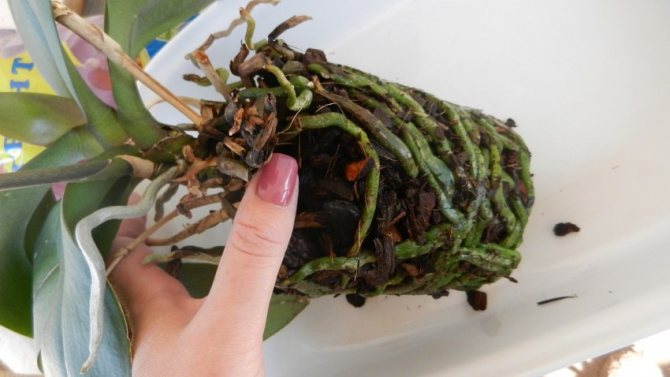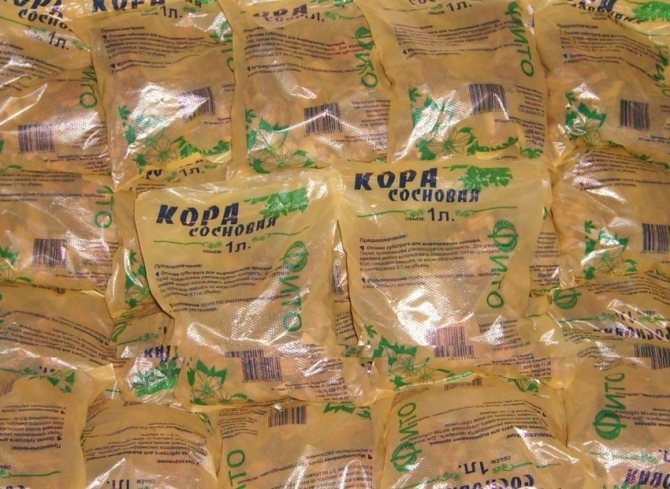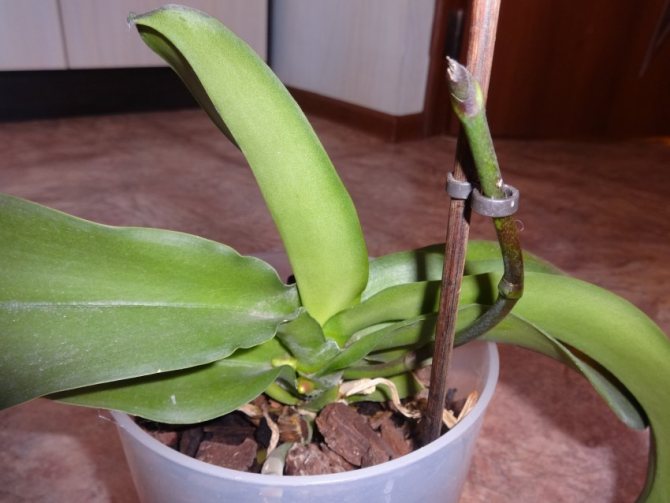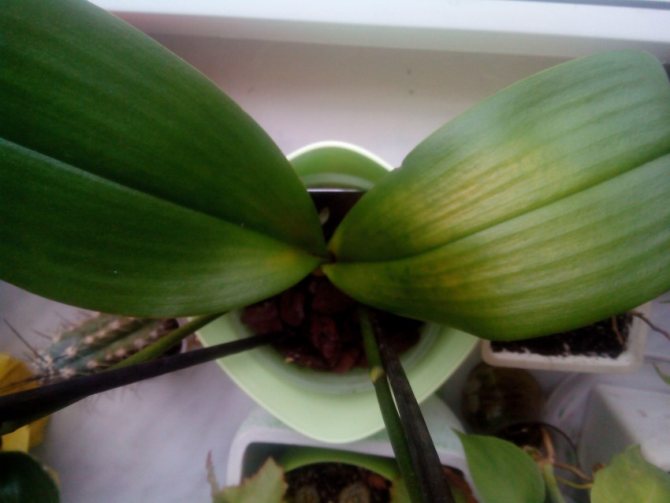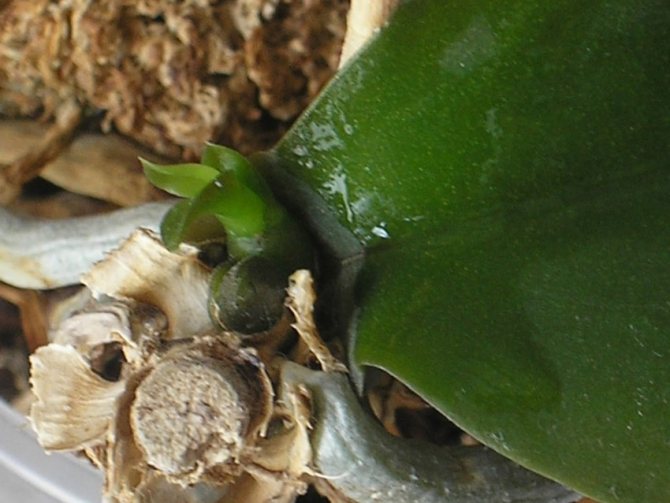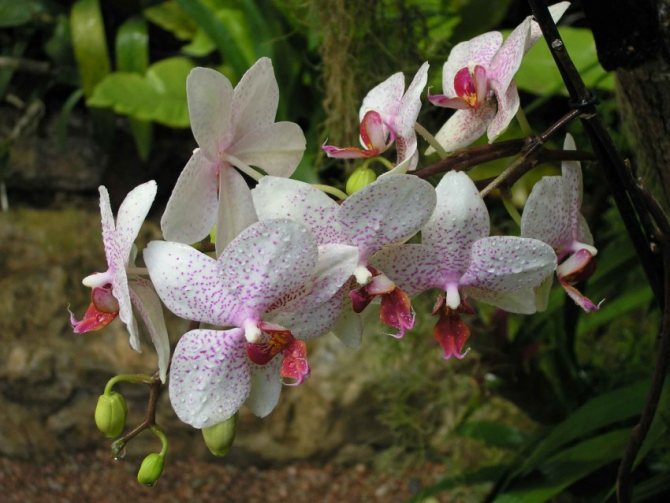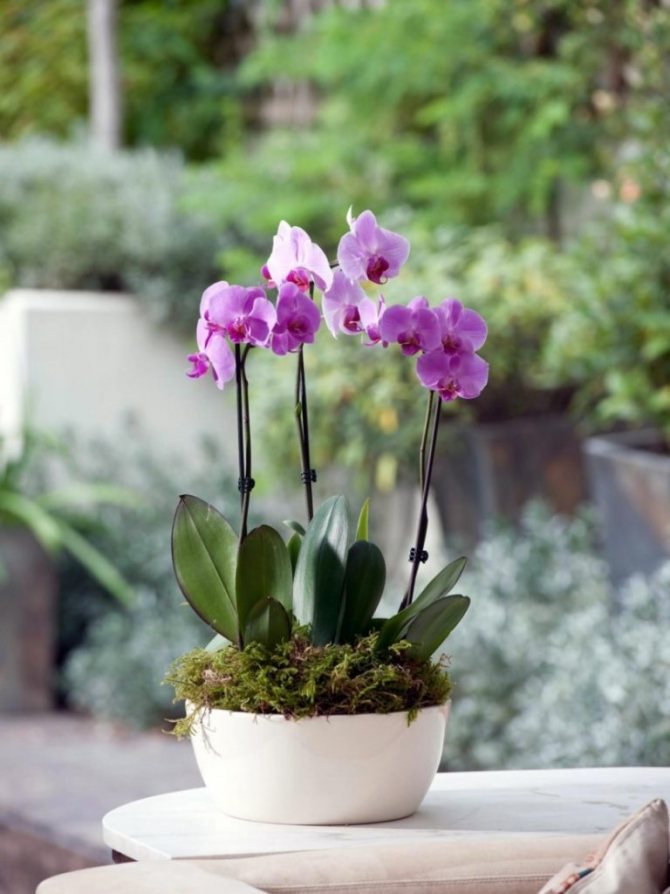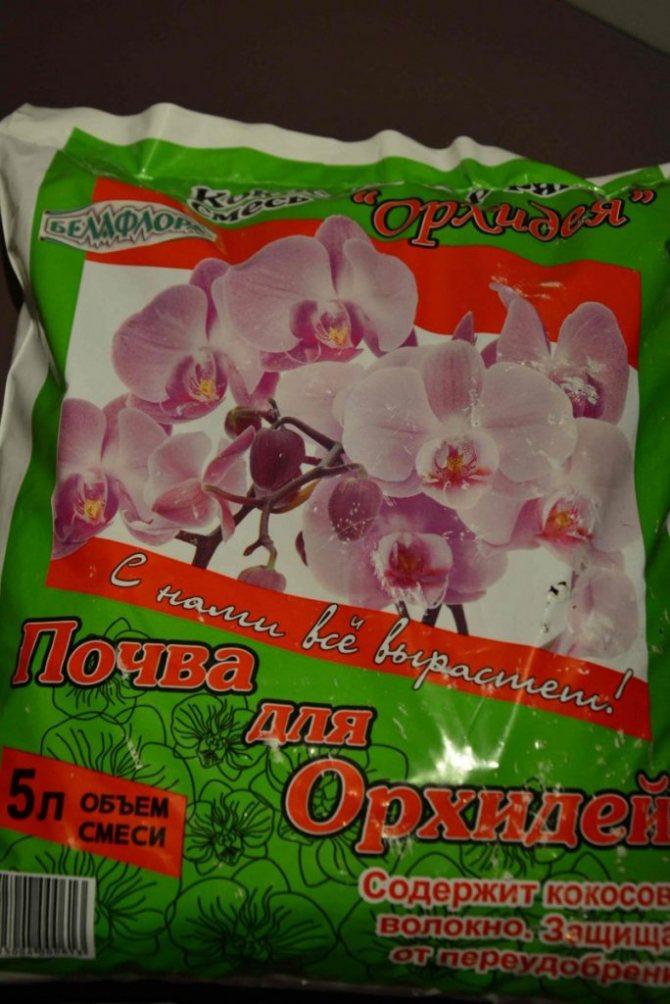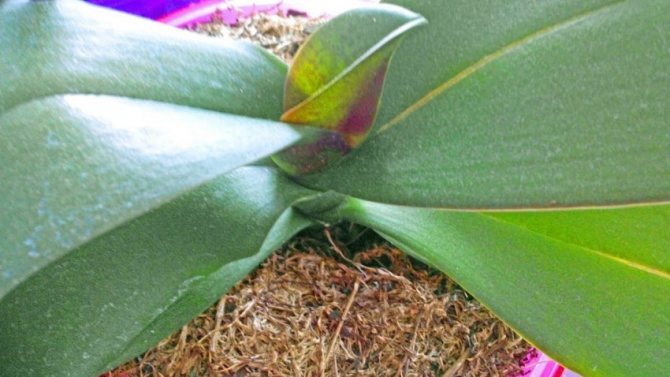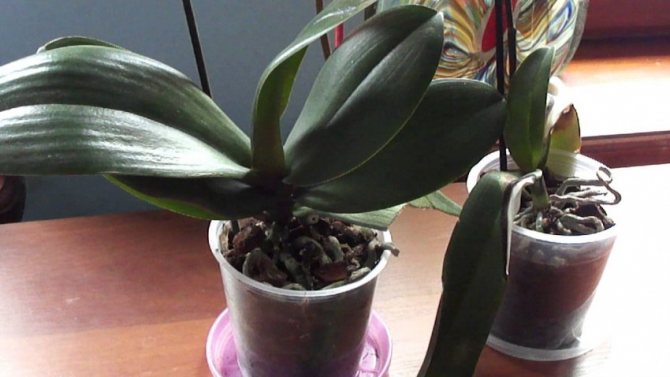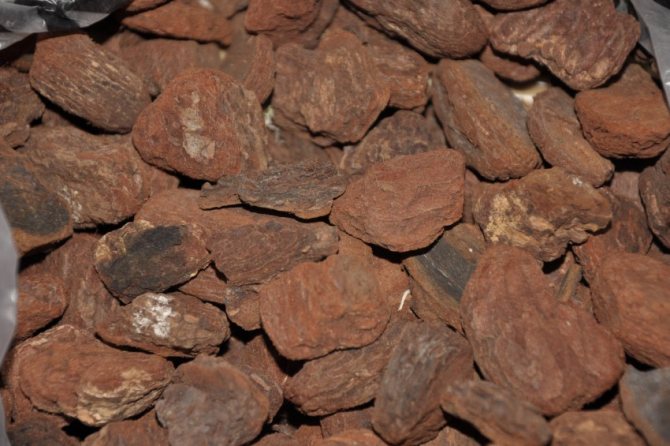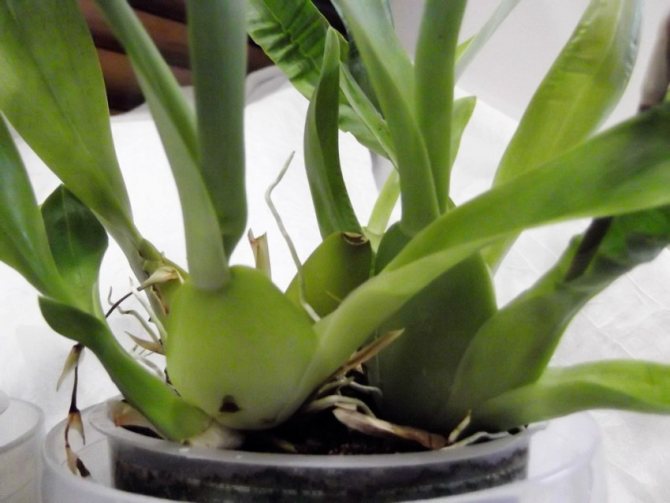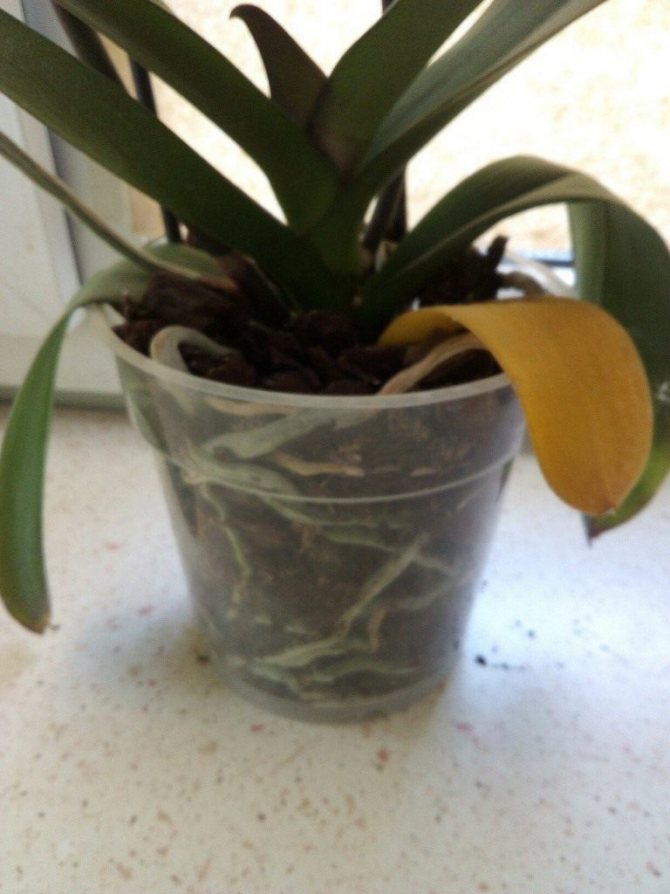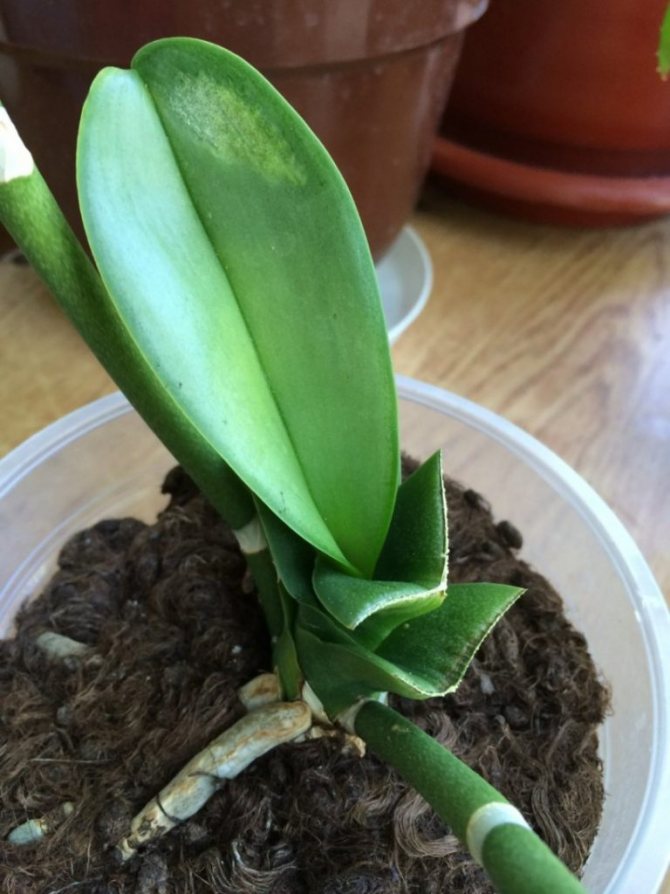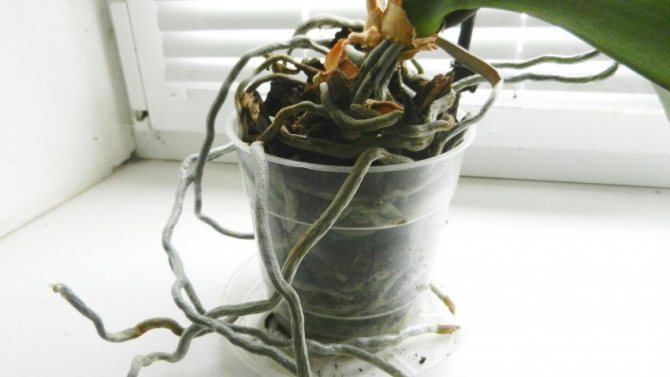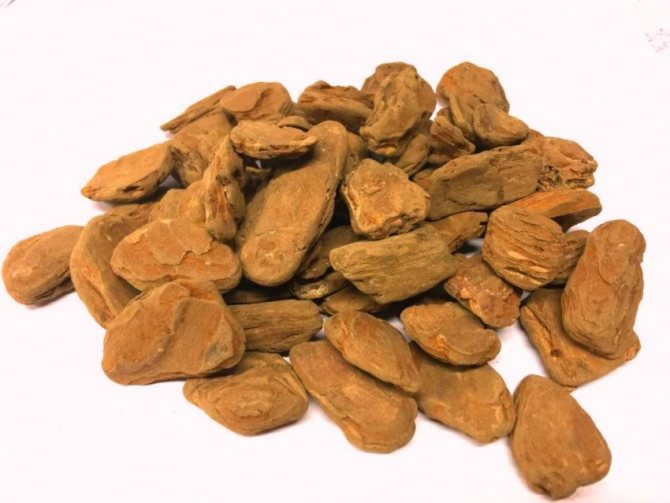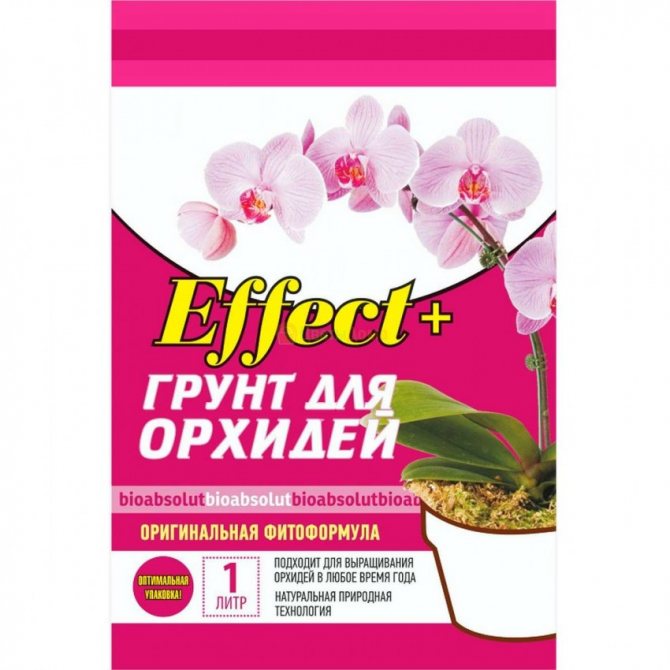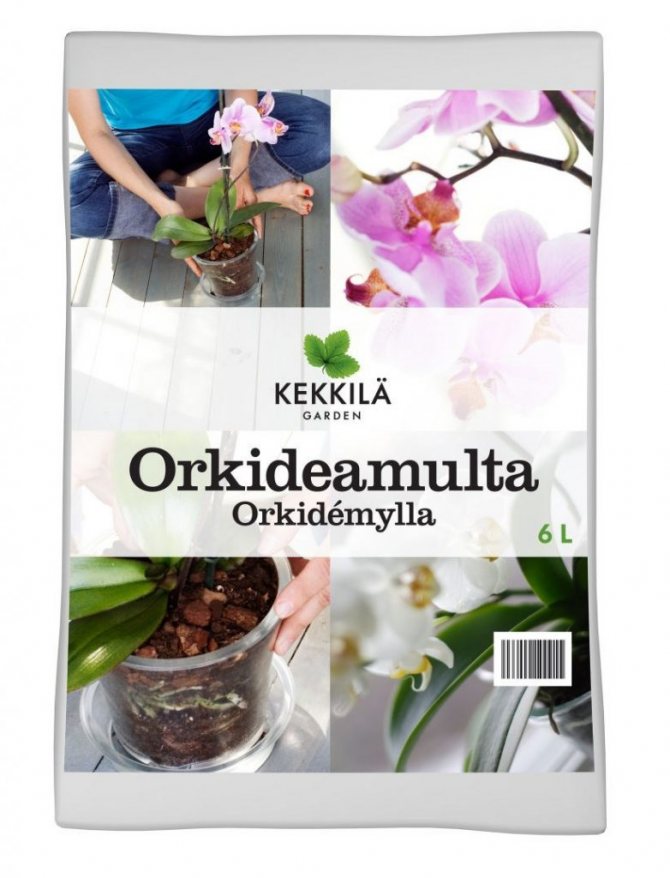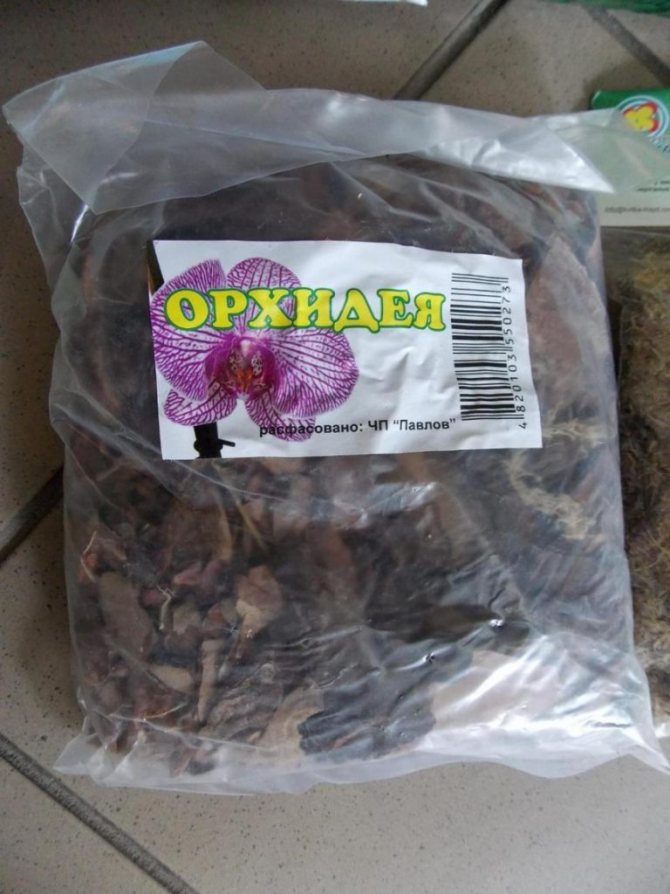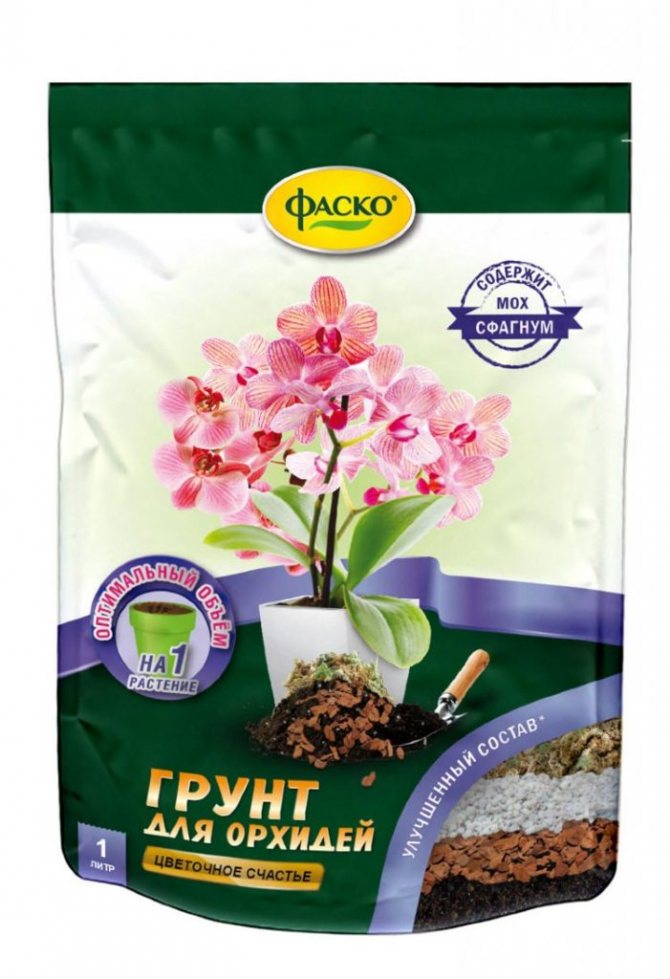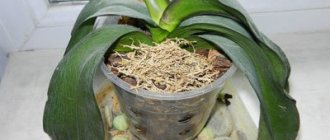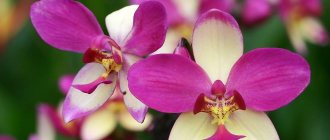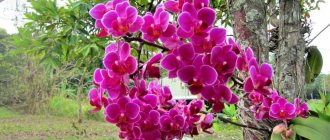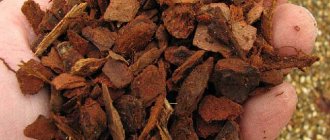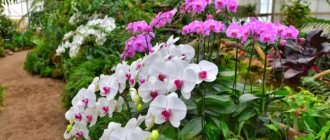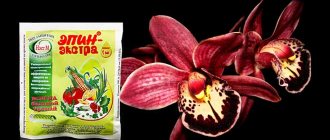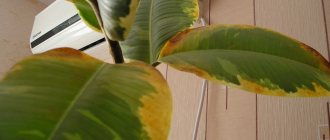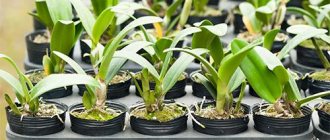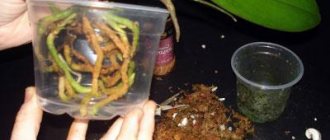How demanding are orchids to the composition and structure of the soil?
Phalaenopsis soil is not suitable, whatever composition it has.
In order to choose the right type of soil, you need to know in what natural conditions this plant grows.
Phalaenopsis grows in tropical forests, mainly on tree trunks, snags and mountain ledges, where the orchid lives without soil. It is not for nothing that its roots are called "airy".
At home by 99% hybrid forms are grownspecially created for this. But this does not mean at all that there is any difference when choosing a soil close to a natural, more natural composition.
Why is it important to plant in the best substrate?
To choose the right soil, you should understand how it differs from soil or soil, for example:
- Land Is a loose mineral coating with all life on the planet.
- The soil - It is a fertile component of the earth with sediments from plant and animal organisms. It is a natural place for plant growth.
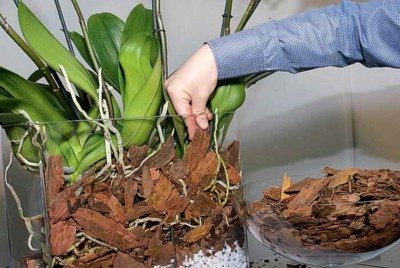
Priming - it is both a mineral natural component of the earth, and artificially created for horticulture. It contains a lot of organic matter that is beneficial for plants.- Substrate - an artificial nutrient medium for seedlings, in which there may be no soil. Literally - this is lat. sub - under and stratum - layer - base, litter (e.g. bark, peat). The main task is to supply the plant with nutrients. Thanks to the substrate, the plant receives air.
In reality, these concepts are confused in flower shops. Purchased substrate may contain soil... Ordinary soil for phalaenopsis is not suitable, since the plant does not need land.
Based on the conditions of his growth at home, he only needs a place to fix the roots. Often, the plant simply wraps its roots around the tree and receives moisture from under the bark.
Selection of substrate
Ready-made soil for orchids is bought in specialized stores. Orchid soil has a complex composition. The ideal substrate can be purchased under the brands:
- Ecoflora;
- Orchiata;
- Fiasco;
- Pokon;
- Kekkila;
- Compo;
- Sana;
- Fasco;
- Gardens of Babylon;
- Queen;
- Florica;
- Effect-Bio;
- Seramis $
- Weltorf.
Recently, a premium coconut substrate called coco has become very popular. This type of land loves most varieties of epiphytes. Soil of this type is sold in tablets, washers, briquettes and in bulk. It needs to be poured into pots in its pure form or made part of a complex soil.
Also, aqua soil is used as a basis for growing epiphytes. It is a hydrogel bead. Such an artificial composition has no nutritional value, but it allows you to retain a large amount of moisture, and then help the plant to consume it in a measured way.
It is not difficult to acquire soil, because its cost is low, but many breeders prefer to prepare soil for orchids with their own hands.
A good nutritious soil for all types of orchids is easy to prepare yourself. You should use blanks assembled with your own hands or purchased in florist shops.A self-made soil mixture at home, subject to the rules and proportions, will not differ from the purchased options.
What composition is needed?
For planting, the bark is ground, boiled in a water bath and dried thoroughly. Large pieces of bark should be placed in the center of the pot so that there is less excess moisture (read about how to choose the right pot for phalaenopsis here). Peat for phalaenopsis should be with large fibers and low salt composition.
Fossil fuel is recommended not to grind. Charcoal adjusts the amount of incoming moisture. But after a while he collects a considerable amount of salts. Florists add it very scrupulously. With further groundbaiting of the plant, you can not add charcoal.
How to make the right choice when buying in a store?
The market for orchid substrates is overflowing with various offerings.
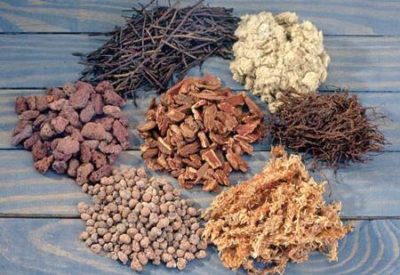

The stores sell both ready-made mixtures and individual components.... But even well-known manufacturers are not always happy with the quality of the goods. Often the soil contains a large amount of peat, which is beneficial for terrestrial orchids, and is contraindicated in epiphytes. Therefore, before buying, it is important to pay attention to:
- The purpose of the substrate, for which varieties of orchids it is suitable. Soil for epiphytic exotic plants is sold under the name Phalaenopsis Mix, and for terrestrial orchids, Cymbidium Mix.
- Supply of components and soil pH.
- The nutritional value of the soil.
- Recommendations for use.
Experienced florists recommend sifting the finished mixturethus, get rid of excess peat and earth dust. And then add the required amount of disinfected bark.
We suggest watching a video on how to choose the right substrate for orchids:
Shop item
In the modern world, it is even possible to purchase a substrate in flower shops. Regardless of the country of origin, you should carefully read the composition.
What should it consist of?
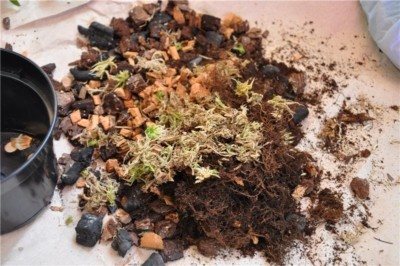

The soil for the orchid should not contain soil... If the store sold the substrate with soil, then you can sift it.
The composition of the purchased culture medium may include all of the above components:
- pine bark;
- chips;
- peat;
- charcoal;
- small sphagnum moss.
How to define good quality?
Not all purchased soil can have a beneficial effect on phalaenopsis. Therefore, when buying, you need to be more careful. Pieces of bark should be whole, dense, without flaws, up to three centimeters in size. They should not crumble in your hands.
The size of the charcoal should be about two centimeters so that it does not crumble either. In high-quality soil, the moss is thoroughly dried and disinfected. The substrate should not look like a hardened lump of earth. If there is earth in the composition, it will accumulate moisture and the air in it will cease to circulate. You may not notice dust and moldy pieces in the package, which will negatively affect the growth of the orchid.
How to choose correctly?
At the time of purchase, you must carefully read the label... It is important to have a composition with a list of components on it, as well as a note that the substrate is suitable for epiphytic orchids. Phalaenopsis nutrients are not required. Artificial foam is also good for their growth.
The best substrate dries in 3 days. Correctly selected soil will make the flower beautiful and lush. An inexpensive and low-quality component will lead to the death of your favorite orchid.
Description of several ready-made soils
- Seramis from Germany... The soil consists of small empty clay lumps. They give the flower moisture instead of pine bark. The big plus of the granules is good air circulation, which affects the strength of the roots. The substrate is suitable for many types of phalaenopsis.
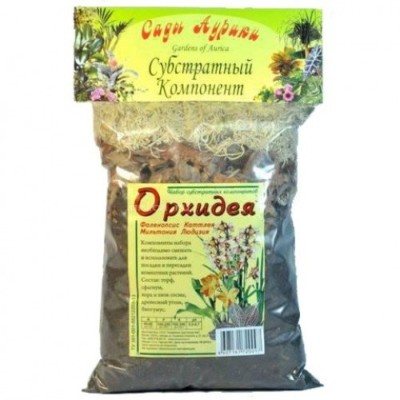

Aurica Gardens... In addition to pine bark and charcoal, the soil contains coconut flakes, the fiber of this nut and sphagnum.For successful use, drainage is required at the bottom of the pot.- Effect and EffectBio... Natural substrate without unnecessary impurities. Provides good air circulation and moisture to adult flowers. Trace elements (magnesium, nitrogen and potassium) together with pine bark make flowering longer.
- Flower happiness... Suitable for all types of orchids. Differs in good aeration and moisture holding capacity.
Phalaenopsis orchid soil: main components and their characteristics
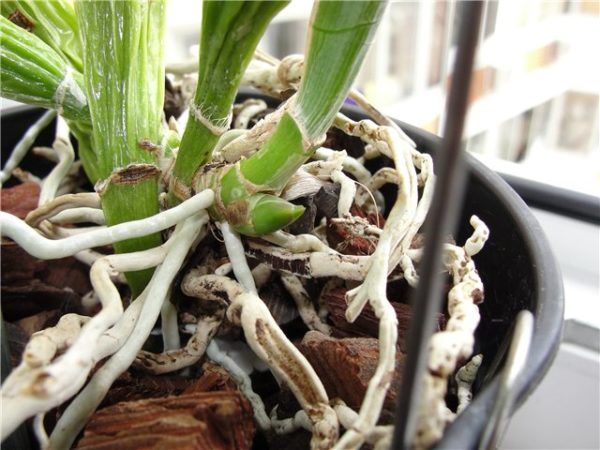

The correct soil is essential for the full development of orchids.
Phalaenopsis land called substrate and its choice is of decisive importance for the full development of the plant.
Structure determined by climate in the place of cultivation - temperature, humidity, illumination.
The structure and components are selected according to the conditions, and by hybrid characteristics, flower size, capacity characteristics, etc.
Only lush flowering and development will give the answer to the correctness in the selection of the composition of the substrate.
The composition or mixture may include the following components:
- Bark of trees;
- Sphagnum moss;
- Coniferous cones;
- Charcoal;
- Vermiculite, perlite and expanded clay;
- Styrofoam;
- Peat;
- Fern roots;
- Fiber from coconut, etc.
Modern flower shops sell specially selected composition for orchids.
But everyone, in principle, can prepare it on their own, following certain rules and recommendations.
Unlike natural ingredients, synthetic have more disadvantages, which are worth paying attention to when choosing and preparing a soil mixture.
When using polymers, it is worth knowing that under the influence of light, elements contained in air and water, decomposition processes occur, as a result of which free form styrene.
And he, in turn, penetrating the roots, causes considerable harm to the plant.
In most cases modern hybrid forms of phalaenopsis not very demanding on the traditional composition of the soil.
But still, each one reveals its hybrid characteristics as much as possible, while observing certain proportions and composition of the components.
Soil or as experts call it - substrate, must meet certain requirements:
- Be light;
- Moisture-intensive;
- Breathable;
- Loose.
Important! The main purpose of the soil is to create plant resistance, close to the natural environment.
Orchidists are used as main component substrate pine barkwith good aeration and moisture holding capacity.
Types of soil for phalaenopsis
There are many types on sale soil for orchids. Eat with natural ingredients, or with artificial ingredients or a mixture of them. Absolutely different proportions in the compositions.
Beginners are very hard to decide, what kind of soil is needed with this choice, but doing it yourself can be laborious or there is simply not enough desire.
It is important to know the characteristics of your plant. and understand the purpose of each component of the substrate and understand the proportions.
Proportions
The proportions are determined by the conditions of the growing area.
- High humidity you can do with only one pine bark with a small addition of charcoal, no more than 5%.
- With medium humidity indoor air (50-60%), sphagnum moss should be added to increase moisture capacity in proportions of 2 to 1.
- If the moisture readings are lower, then add moisture-consuming components in a ratio of 1 to 2.
Compositions
The composition of the substrate is also very diverse., but the bark remains the main components and very rarely, some growers use leafy soil.
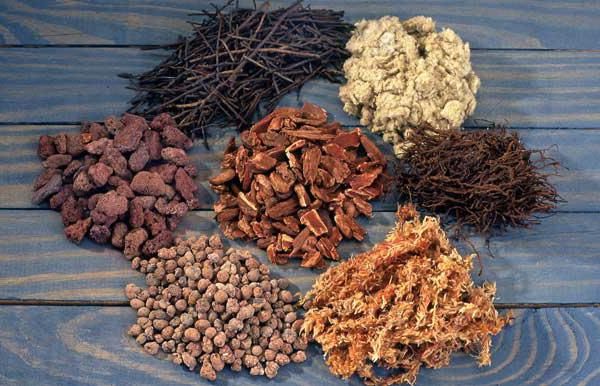

Various types of soil for Phalaenopsis orchids.
Composition is determined by understanding the existence of a plant in nature.
Like an epiphyte, phalaenopsis does not require rooting, but grows due to symbiosis with crops of woody origin.
At home this function is performed by the bark, in which a large number of fungal cultures parasitize.
The rest of the components are of secondary, but still necessary, importance for full development.
How to do it yourself at home?
It is easy to prepare the substrate at home thanks to the Internet and the knowledge gained. The size of the components is directly proportional to the thickness of the roots: thicker - more.
What does it include?
Home soil components are similar to purchased ones.... The composition includes:
- spruce or pine bark;
- moss;
- charcoal;
- peat;
- fern root.
The composition is prepared before the transplant. It is impossible to pre-mix the soil.
Comparison with purchased
When comparing soils: from a store and your own - it is impossible to give an assessment... In the store, the proportions and rules of preparation are already strictly observed. The ingredients are natural, but the quality does not always meet expectations. You will be confident in your home-made substrate.
However, there is an obstacle - not all components are easy to obtain. The best option for phalaenopsis is a remedy from a store with the addition of its own ingredients.
Pros and cons
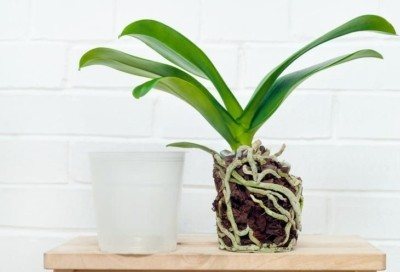

Pros of making home soil:
- budgetary cost;
- high and reliable quality;
- the choice of components specifically for the plant variety;
- observance of proportions.
There are fewer minuses of such soil, but they are:
- Some components are difficult to obtain.
- Another disadvantage concerns the pine bark. There is a possibility of bringing insects into the house, and the search and preparation of the bark itself is a difficult process.
Where can I get the components?
Pine bark can be found in the forest, preferably from or near felled trees. This will reduce the amount of resin. Coal is one of the simplest components. It can be found at the site of a campfire after tourists are resting.
Peat is difficult to obtain, so you can buy it in specialized stores. Secondary soil components are also collected in the forest.
How to make: step by step instructions
To make the substrate, you will need a spatula, scissors, a knife and bags... It will take some time to prepare the components:
- Moss should be covered with water for one day and then dried.
- The bark is crushed into chips and sterilized in a steam bath for half an hour. Then it is dried.
- The coal is crushed into pieces of two centimeters.
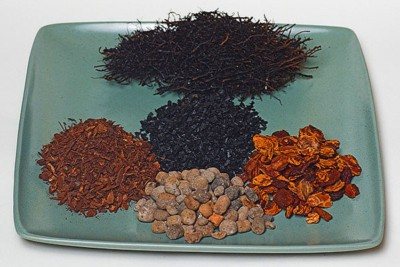

Peat is also divided into small particles.- The fern root is washed in warm water, poured over with boiling water and then dried.
Popular methods for preparing the substrate:
- Coal and bark in a ratio of 1: 5.
- Coal, moss, pine chips in a ratio of 1: 2: 5.
- Peat and bark in equal proportions with ⅓ deciduous land.
Step-by-step instruction
Describing the process in detail will eliminate unnecessary errors and will add confidence in action. So, how to carry out a transplant with a soil replacement:
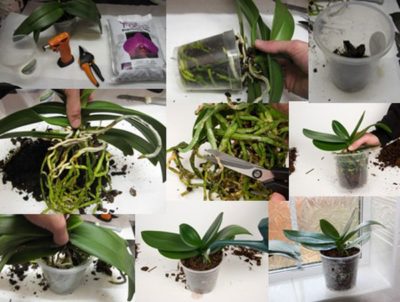

First, remove the flower from the pot. To make the process easier, you can crush the plastic pot a little and gradually stretch the plant. If the flower cannot be reached without obvious effort, the pot can be cut into two halves.- We free the roots from excess soil. Gently pull out the roots from the chips, old particles of the substrate. Then we rinse under running warm water.
- It is important to examine the root system. We cut off dry, rotten, yellow branches with a sharp tool (for more information about whether it is possible to cut the roots when transplanting an orchid and how to do it correctly, read here). Treat the cut sites with sulfur or ash.
We offer you to watch a video instruction for transplanting an orchid:
It is not difficult to choose a soil and make a transplant, but it is so important. The further full development and exuberant flowering of the orchid depends on this. BUT subsequent proper care and care will ensure a quick adaptation of the beauty.
If you find an error, please select a piece of text and press Ctrl + Enter.
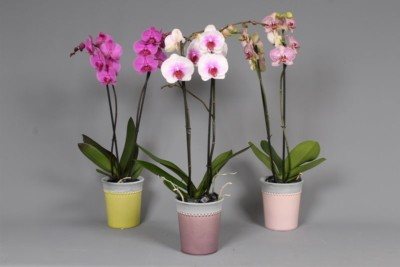

Phalaenopsis belongs to the genus of epiphytic orchids. The often flowering plant (twice a year for two to five months) is popular with plant lovers.
The epiphyte orchid grows in the tropics. It differs in that during growth it settles on other plants. The flower feeds on bark, rain and air. Photosynthesis is inherent in its roots.
Possible consequences
Incorrectly selected or prepared soil will harm the roots of phalaenopsis... Due to the dense substrate, the orchid can rot.
You can find out when it is best to transplant the phalaenopsis orchid at home here, and from this article you will learn about the planting rules.
For a luxurious, healthy plant and constant flowering, responsibility for the choice of soil will not be redundant. Without the right substrate, serious problems will arise when caring for phalaenopsis, up to and including the death of the flower. Carefulness when buying or making soil will bring wonderful fruits of floriculture.
If you find an error, please select a piece of text and press Ctrl + Enter.
Most of the orchids are epiphytic plants, so the most important feature of their cultivation is the careful selection of the substrate. The slightest mistake in the composition of the soil can cause the death of this delightful flower.
Substrate requirements
The soil mixture for orchids must meet the needs of the plant and its conditions of maintenance. So, for example, in a dry room climate, it is necessary to take a more moisture-absorbing soil. The condition of the soil must be constantly monitored. At the initial signs of decomposition, the plant should be transplanted or the substrate should be partially replaced.
Mandatory soil requirements for epiphytic orchids are the following characteristics:
- Air permeability, porosity. For the proper functioning of the root system, oxygen is needed, which is displaced by the moisture moving inside the root.
- Stability. The substrate should maintain its shape as long as possible, not rot or decompose.
- Moisture capacity. The lower the humidity in the room where the orchid is located, the higher the percentage of moisture-consuming components should be in the soil.
- Not favorable to pests... The soil should maintain sterility for as long as possible, maintaining the minimum necessary for the existence of fungi, but preventing the mass reproduction of fungal parasites and harmful organisms.
Some problems caused by poor quality soil
Choosing the wrong soil for a flower is often associated with many problems. So, sometimes there is a white bloom on the substrate of the orchid, which resembles fluffy yarn. It is a mold caused by wood decay processes. When the substrate is chosen incorrectly, or it has stuck to the root system too much, a similar problem arises.
Shaggy mold on the orchid substrate can eventually spread to the flower itself, covering not only its roots, but also the stem. The ideal environment for fungus is high humidity. If the culture is watered too often, and the substrate does not have time to dry out, such a problem arises. It can significantly disrupt the full development of a flower or even provoke its death. You can save the plant if you transplant it, carefully removing all affected areas and replacing the soil.
If the roots and substrate of the orchid are covered with a silvery coating, then there is nothing wrong with that. This is the normal state of a healthy flower when the soil in its pots has dried out. In this situation, you do not need to sound the alarm. Read the article: Resuscitation of an orchid without roots and with sluggish leaves.
Composition of the substrate
The main components of the soil for orchids are pine bark, sphagnum moss, peat and coal:
- The most important component is pine barksupplying the roots with air and moisture. You can use the bark of spruce or other trees.It is important to remember that it strongly absorbs nitrogen, as a result, the flower may be deficient in this element. Additional feeding will help to correct the situation.
- Coconut fibers are an excellent medium for the development of an orchid., perfectly retaining moisture. They can be used alone or together with other soil components. The size of the particles of coconut fibers is selected in accordance with the requirements for humidity and the amount of oxygen. The advantage of the fiber is its organic origin, breathability, environmental friendliness and moisture capacity. It is absolutely harmless, does not contain pathogenic microflora.
- Young orchids need to add sphagnum moss to the soil, which is changed annually.
- Sphagnum peat is included in the soil in order to accumulate moisture, therefore, its structure remains coarse. Peat should contain a minimum amount of salt.
- The share of charcoal in the soil mixture is no more than 5%. The positive quality of coal, adsorption, in this situation has a small drawback: sooner or later coal will accumulate a large amount of salts, which will negatively affect the acid-base balance of the soil. It is not recommended to add coal if the main component of the soil is bark, and the plant constantly needs mineral fertilizing. You can correct the situation and reduce acidity by adding dolomite flour to the soil or replacing charcoal with apple leaves, which will also help prevent the appearance of pathogenic fungi.
- To improve air circulation, vermiculite is often included in the soil for orchids.... This mineral loosens the soil, protects against infections, drying out, prevents soil caking, as a result of which the roots form more evenly. The ability of vermiculite to keep fresh in hot summer will protect the plant from temperature extremes. Pearlite has similar qualities.
DIY components for compiling a substrate
Flower shops offer a wide range of ready-made potting mixes for flowers, including orchids. However, experienced gardeners prefer to collect soil for their pets on their own.
It is not difficult to make an orchid soil mixture, the main thing is to observe the proportions. If everything is done correctly, the plant will thank the owner with exuberant flowering.
To work, you need the following components:
- tree bark, preferably pine;
- refined charcoal;
- coconut fiber;
- small-sized expanded clay;
- peat mixture;
- fern roots;
- swamp moss (sphagnum);
- pine cones;
- deciduous humus.
All of the above components are not strictly required, you can only add what was found to the soil:
Soil for orchids: composition
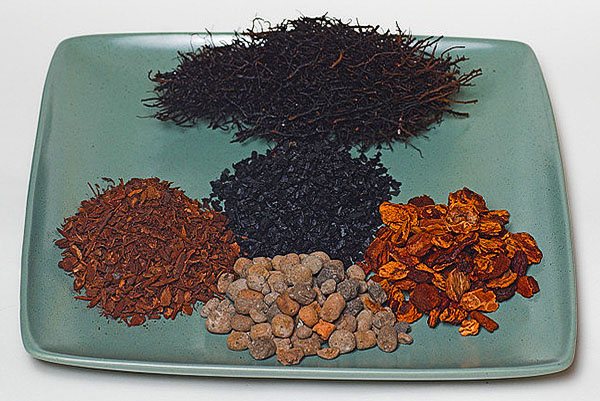

An orchid requires special treatment and unusual care, in comparison. With other indoor plants. Although it is considered the most unpretentious of tropical plants that have adapted on our windowsills, you will have to make an effort to make the right soil for orchids at home, to provide it with the necessary watering and lighting regime. Let's first figure out what the soil consists of, about which we talk so much today.
Tree bark
If you look at most of the substrates that are offered in stores, you can see quite large pieces of tree bark. Yes, this is the main component of the substrate. Moreover, the bark should be pine, cedar or spruce, that is, it should be directly related to conifers. You can collect it yourself in the forest or even in the park. It is best to find a dry tree in order to remove the bark from it, but you can also use those pieces that it "gives away", that is, you can remove them without much effort.
The pieces should be completely dry, from damp orchids there can only be harm, even after many hours of digestion.Having brought home, the bark must be sorted out, all areas with mold, fungi, wet and without hardened resin must be removed, put in a saucepan and boiled, then dried and chopped.
Sphagnum moss
Anyone who previously grew epiphytes, and any other plants that require a moisture-retaining substance, know exactly what sphagnum marsh white moss is. In dry form, in which it can be purchased in a store, it looks like a washcloth, and in fact it is, as it "knows" to efficiently accumulate and accumulate moisture. Such moss must be included in the composition of the soil for orchids.
Many types of such flowers exist quite comfortably, and besides, they also bloom in sphagnum alone, but it all depends on the type of plant. Such a component can be used fresh and dried. It can be simply chopped with scissors and mixed with the main substrate. Interestingly, this amazing moss also has antiseptic properties, which people used in the old days, tying it to bleeding wounds. If you are not well aware of what sphagnum looks like, it is better to buy it at a special outlet.
Lowland peat and coal
Just like white bog moss, low-lying peat is intended for growing flowerpots to accumulate and retain moisture for a long time, but you need to choose it correctly. Firstly, it must be salt-free, and secondly, it only needs to be slightly broken into pieces without crushing it too much. It is hardly possible to get peat with your own hands, so you will definitely have to buy it.


In order to adjust the acidity of the soil, charcoal must be added to the substrate, which by default should be woody. True, over time, as a high-quality absorbent, coal will accumulate salts in itself and it will need to be replaced, and together with the rest of the composition components. It is not difficult to get such coal, you need to take cinders from the fire, rinse, boil and dry. If fertilizers are applied to the soil, then it is better not to add this component, it will accumulate excess insoluble and soluble salts, which can harm orchids.
Fern or coconut
Another popular ingredient that is often found in the soil for growing beautiful orchids is dried fern roots. It's easy to get them. You need to dig up the plant, choosing a larger one, cut off the top, and clean the rhizome of the earth and rinse very thoroughly. After washing, they can also be boiled for five to seven minutes, dried and cut into small sections, about two to three centimeters.
The second option is to buy coconut fiber and not bother with ferns, looking for them in the surrounding forest belts and parks. Alternatively, you can choose a coconut substrate, which is small briquettes of broken nut shells, along with the hairy part. The cost of such briquettes is lower than that of pure fiber, and in terms of quality they are not inferior to it in anything.
Verliculite, expanded clay, perlite
In addition to organic components, soil for orchids should also have inorganic ones, for the role of which the building material expanded clay, a mica-based mineral vermiculite or perlite is the best suited, which is well known, since it is from it that fillers for cat litters are made.
All of these components have a somewhat absorbent, but mainly draining effect, and they are all available for purchase. Folk craftsmen manage to use even pieces of old brick for such purposes, but with orchids this is not the best choice, since from time and regular irrigation they collapse, turning into dust.
Remember
Most often, at home, land for an orchid is not required, both leafy and ordinary.Therefore, it needs to be added to the substrate only when it comes to terrestrial plants. However, if you need it, then you can take it straight from the street, but you will have to go through it very carefully and bake it in the oven for at least twenty minutes.
Making a substrate with your own hands
When making soil for orchids yourself, you need to follow several principles that allow the plant to take root in new soil and develop well:
- the lower the humidity of the ambient air, the more moisture-consuming components in the soil;
- the soil should be loose, not compacted;
- ideally, the substrate should dry out in 3 to 4 days.
The process of making the mixture consists in the correct processing of all parts that make up the soil mixture:
- Collected according to all the rules the bark is crushed.
- The peat is divided into enough large particles.
- Components are thoroughly calcined and dried.
- Freshly harvested sphagnum is soaked in clean water for 24 hours. The procedure will expel insects that will float to the surface.
- Fern roots are washed with running water, preferably with a shower head, are doused with boiling water to kill possible pests, then chopped into small pieces.
- The bottom of the planting tank is covered with a drainage layer consisting of expanded clay, foam, small pebbles or gravel. Further, up to about half of the pot, there is the soil. The central part of the bowl is also filled with a generous layer of drainage, on top of which prepared soil is laid out. The container can be filled freely, without sealing.
Substrate treatment
How and why to sterilize and rinse?
It can contain harmful microorganisms and bacteria.
Unscrupulous manufacturers, if stored improperly, can allow fungal diseases in components.
If you pick it yourself, you can also harvest the same bark stuffed with pests.
For disinfection it is customary to expose it:
- Heat treatment;
- Boiling method;
- Watering with boiling water;
- Firing in the oven.
After heat treatment is carried out soaking in cold water, and then complete drying.
How to disinfect?
Some experienced orchid growers recommend treating with a solution of furacilin or potassium permanganate.
Basically, a good heat treatment is enough to protect the plant from harmful microorganisms and pests.
Plus, the moss itself is a good antiseptic.
Major mistakes
Inexperienced growers are often mistaken when choosing a substrate for planting an orchid. In order to avoid failure when selecting the soil, the following nuances must be taken into account:
- ordinary land is not suitable, loose, airy, light soil is required;
- the soil must be porous so that the water does not evaporate into the air, but is absorbed by the roots;
- the substrate must be resistant to degradation;
- the soil and all its components are disinfected in any available way;
- the selection of components takes into account the requirements of different types of orchids.
Can regular soil be used?
You should not choose ordinary soil as a substrate. for exotic plants. After all, the root system needs light and oxygen for the process of photosynthesis. That is, the substrate should be composed of lightweight, breathable components. Otherwise, the heavy earth will be a kind of press for the roots.
Also, dense soil can lead to a violation of the drainage process, and stagnant water will negatively affect the root system. It will be difficult for orchids to fully grow and develop in such conditions.
Do not forget that the usual habitat of exotics is loose, light soil or its complete absence. BUT ordinary earth is a dense enough environment in which the orchid simply will not survive.
Tips "florists
For orchid lovers who have just come into their hobby, it is better to start with buying a substrate in the store, be sure to pay attention to the type of plant for which the soil is intended, if this information is indicated on the label.
An experienced florist can quite successfully create the soil for a pet on his own, using the rules and recommendations described above.
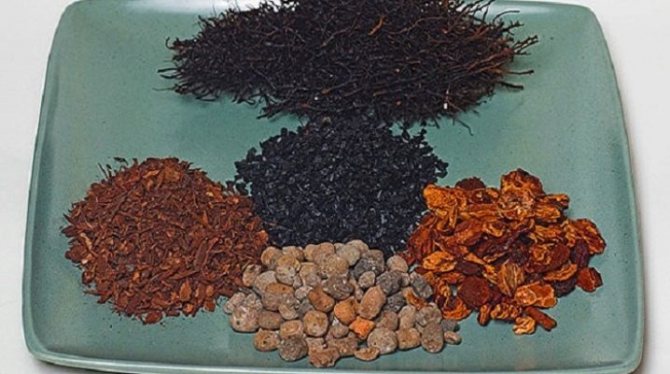

The quality and composition of the soil substrate are important criteria for the full development, growth and flowering of orchids. On sale you can find ready-made substrate mixtures recommended for growing these exotic beauties. Consider which brands are popular with modern flower growers, and whether it is possible to prepare a good substrate for orchids at home. What else a grower needs to know about the substrate required for breeding capricious orchids - this will be discussed in the article.
The most popular purchased substrates and soils
There is a wide selection of different composition of the substrate for orchid:
- "OVI";
- Flower Happiness (Fusco);
- Lechuza-Pon;
- Soil mixture for orchids "Effect";
- Orchid Focus Repotting Mix;
- "Orchid";
- "PEATFIELD";
- Florin for Orchids and many others.
A lot of components on sale for soil preparation.
You can buy separately and prepare a high-quality substrate necessary for your conditions.
What substrate is needed for orchids?
In the tropics, which are the natural habitat of these delicate exotic plants, orchids do not grow from the ground at all, as novice growers mistakenly believe. Possessing aerial roots, these sissies receive the necessary moisture from the air, while rocks, thickets of moss, stumps and trees serve as reliable support for them. Ordinary, even very good and fertile soil is not suitable for orchids. Simple soil is not able to create a full-fledged environment for fragile aerial roots that ensures development and growth. For this reason, experienced florists use a special mixture called a substrate to grow exotic plants.
The composition of the substrate and the proportions of its components may depend on the varieties of orchids grown, on their demand for the presence of certain ingredients. Found in modern gardening stores and universal mixtures, suitable for growing most of the known hybrids. The main ingredients of such mixtures are usually:
- peat;
- sphagnum;
- shredded tree bark;
- vermiculite;
- perlite;
- coal;
- humus;
- clean and coarse sand.
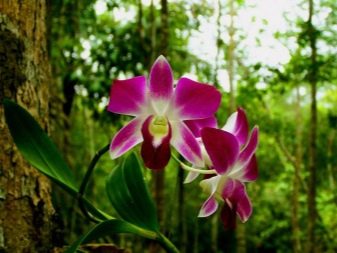

Sometimes quite unexpected components are found in the composition of universal substrates. These include fern roots, coconut and cork fibers, pine cones, foam and volcanic rock fragments.
Depending on the proportions and characteristics of the components included in the composition, the substrate for orchids is air-, light- and moisture-permeable. It allows the roots to get the moisture they need, while providing air and even light for them.
When watering, the water in the substrate does not stagnate, but its components remain moist for a long time. This allows the delicate roots to avoid drying out, which is detrimental to the condition of tropical plants.
Light fragments of the substrate do not put pressure on the fragile aerial roots of orchids, but at the same time provide them with protection from temperature extremes, direct sunlight, mechanical and other damage. The individual components of the mixture also protect the root system of exotics from pathogenic bacteria and pests.
A number of requirements for the soil mixture (substrate) for orchids includes such criteria as:
- environmental friendliness;
- water permeability;
- factionalism;
- breathability;
- ease.
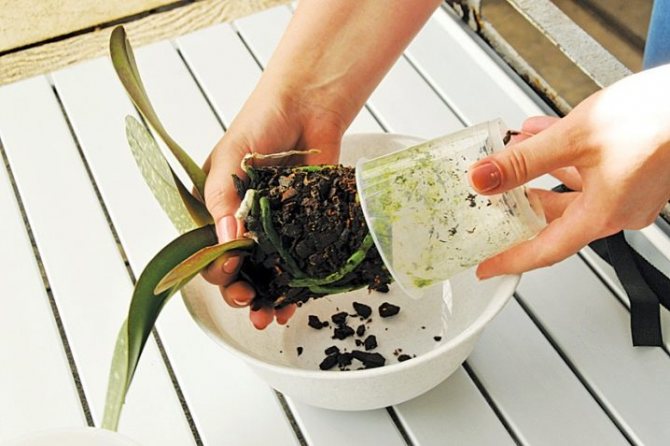

In addition, a substrate suitable for exotic plants is characterized by a loose structure and an ability to retain nutrients.Specialized mixtures designed specifically for growing orchids do not contain small fragments, dusty particles, which lead to caking and compaction of the substrate over time.
When growing orchids, it should be borne in mind that during the flowering period, they consume a large amount of nutrients from the substrate. For this reason it is recommended to transplant plants into a new substrate every 2-3 years, replacing the depleted mixture with it. For transplantation, it is desirable to use a substrate with the same composition to which the exotic is accustomed to during its existence. Before transplanting the plant, the mixture is laid in layers. First, a drainage layer is laid on the bottom of the pot, then the substrate is poured to half of the container, after that the drainage is again laid and the filling with another layer of the substrate is completed.
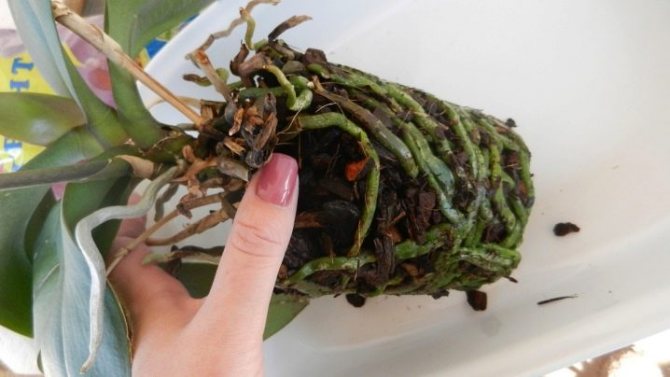

Components used: which is better?
Pine bark
The most common component of the substrate.
To some extent not a natural environment for orchids, but when grown at home, it has all the properties that a plant needs - uniformity of moisture distribution and provides maximum air intake.
Resin and harmful insect content requires heat treatment before using.
Oak bark
Has the same properties and also requires heat treatment.
If the resin is removed from the pine bark, then at the oak — tannins... Cork oak has a good recommendation.
Peat
Basically, high-moor peat is used:
- Possessing a very high moisture capacity;
- The ability to absorb and retain nutrients.
One of its main advantages is that even when completely saturated with moisture, it able to hold a decent amount of air.
Of the shortcomings, it should be noted increased aciditythat you want to neutralize.
Advice! 10 g of dolomite flour per 1 kg of peat brings the peat into a neutral state within 10-14 days.
Coconut fiber
Organic component, which is superior to sphagnum peat in some characteristics. Good guide and moisture absorbent. Regulates soil moisture.
Anti-tracking and lump formation. Okay breathes air... Found wide application in growing on blocks.
Contains as part of K, Ca and a little bit N.
Expanded clay
Many flower growers use as drainage expanded clay... Of course, it also has certain merit.
But its porous structure is not only retains moisture wellbut also has the ability to accumulate salts in oneself, which are part of any water that is watered on an orchid.
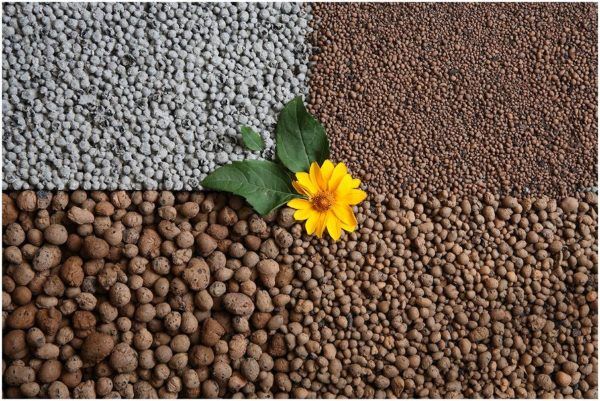

Expanded clay is moisture resistant and is able to accumulate salt from water.
In the future, there is salinity of the entire substrate and the ability to absorb vital moisture is lost.
Another disadvantage is considered to be its unnecessary ability. draw moisture out of the roots when it dries.
Styrofoam
Applied as drainage component And How stability element. Good air permeability.
According to orchid growers no harmif light and neutral foams are used.
Vermiculite
Excellent baking powder any soil. Does not allow it to dry out and crumple. Effective regulator air - water balance.
Has the property absorb moisture several times its own weight, which reduces the time spent on watering.
Contains a sufficient amount of useful microelements... Reduces salinity and acidity.
Sphagnum moss
One of the widely used components when creating a substrate.
Possesses high ability absorb water vapor from the air (hygroscopicity).
In addition, it contains a lot beneficial trace elements and nutrients, which is not in the bark.
Microflora poverty does not allow the development of pathogenic bacteria.
Charcoal
One of the most common soil components, but no more than 5%... Recommended as a substance improving air and water permeability.
Does not allow the soil to become waterlogged, prevents acidification. Excellent antiseptic, preventing the formation of putrefactive processes.
Increases the pH value, it is considered mandatory for use as an absorbent component.
Activated carbon
Applied as disinfectant for problems with the root system and its treatment.
The tablet is crushed and the cut sites are sprinkled with activated carbon, which often happens during plant transplantation.
Natural cork fiber
Used as replacing moss or coconut fiber... Highly rarely used when growing due to the rarity in the flower market.
Pine cones
Whole buds do not recommend using due to the presence of resin and the ability to open and close when humidity changes.
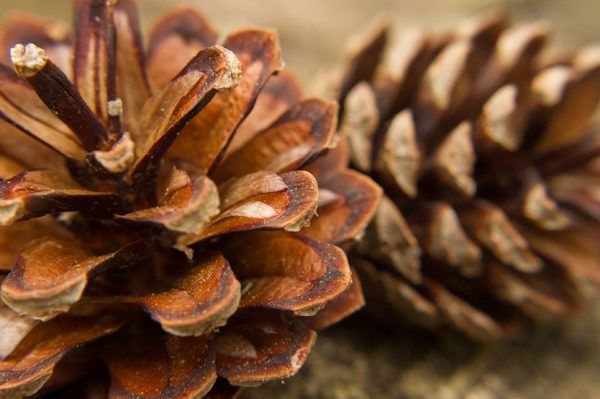

Pine cones are used as an additive to the main substrate.
Use stiff scales as an additive to the main substrate. Some growers use pine cones as a growing block.
An original, but rather laborious task to create and maintain.
Humus
A small amount can be used in the substrate quality deciduous humus.
The danger is being in it pathogens and insects.
This also applies to diluted horse humus. His needs to be disinfected or not at all.
Perlite
Substance volcanic origin... In terms of functionality, it is similar to vermiculite, but does not contain nutrients.
Osmunda fern roots
In previous years were the main component substrate.
Currently in short supply bark is mainly used.
Component Description
When planning to choose the most suitable substrate for exotic pets, you should familiarize yourself with the features of each component. Modern manufacturers producing such mixtures very carefully monitor not only the recipe and proportions of ingredients, but also pay a lot of attention to the quality and properties of all components.
Shredded tree bark (usually pine) is one of the essential basic ingredients found in almost all types of substrates. Less commonly, growers use oak or birch bark. Bark fragments provide the necessary nutrition for plant roots, maintain oxygen access and maintain an optimal level of moisture. For self-preparation of the substrate, you need to use the bark removed from old, felled (but not living and still growing) trees or stumps.
Before preparing the mixture, the bark must be thoroughly heat treated.
Sphagnum moss is another basic ingredient required to maintain optimal moisture and root nutrition. Being hygroscopic, moss absorbs harmful salts in hard water. In addition, this ingredient gives the mixture lightness, airiness and friability, which are important for the delicate root system of exotic plants.
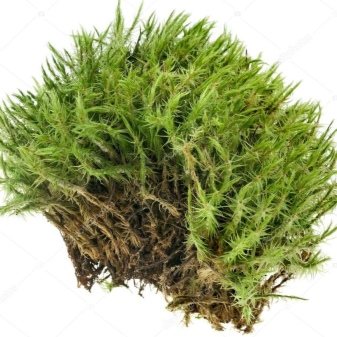

Peat is an organic ingredient often found in mixes for breeding and rooting exotic plants. It is mainly used to give the substrate looseness, as well as to provide additional nutrition to orchids.
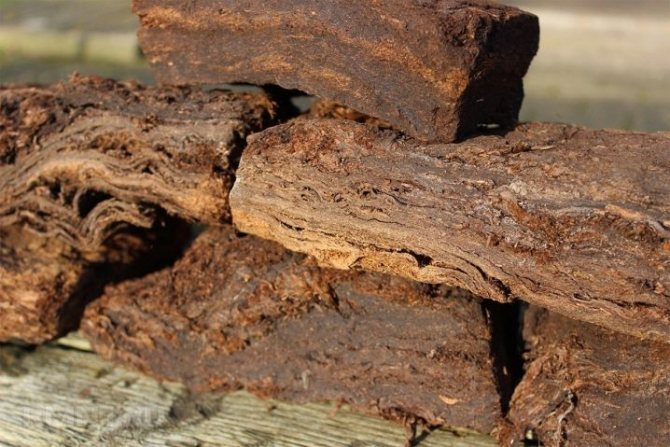

Vermiculite and perlite are substances used in mixtures to improve aeration. Both components are used as drainage, providing air access to the plant root system. In addition, the use of these agents improves the water-holding properties of the substrate, which allows for longer intervals between waterings.
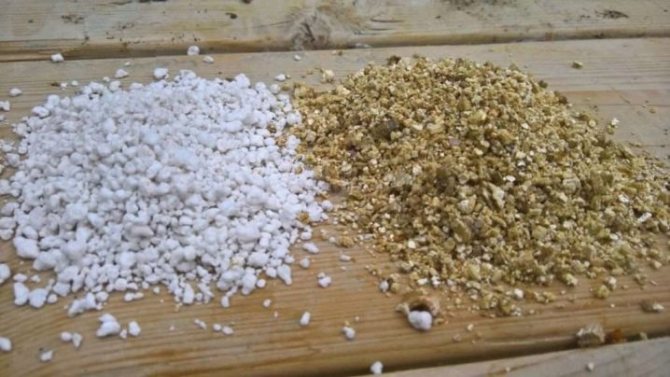

Charcoal is an important ingredient with bactericidal and sorbing properties.Due to the presence of this component in the composition of the substrate, excess moisture does not stagnate in the pot, and harmful microbes and fungi do not harm the roots of plants. Moreover, Given the antibacterial properties of charcoal, flower growers recommend using it in the form of a fine powder for processing slices on orchids.
Sanitization
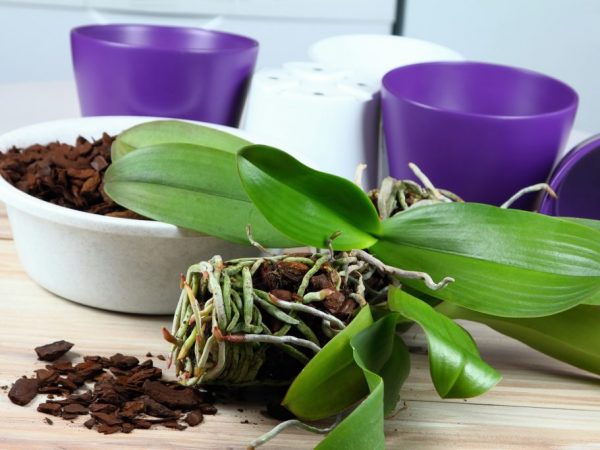

We wash the roots of the orchid
Before using any of the substrates, a sanitary preparation is required. The most correct way to process the substrate is:
- the washing up;
- heat treatment (roasting in the oven or boiling);
- easy drying;
- grinding.
The bark for the substrate is taken only from non-living trees, and then treated with an antiseptic. The moss is soaked in salt water for a day, after which it is rinsed and dried. The shells of nuts, cones and coconut threads are treated with boiling water.
Precisely such actions will have to be performed in the case when the soil:
- turned green;
- got too wet;
- covered with a white coating from hard water.
Popular brands
In modern stores, you can find a wide range of substrates of various brands. The products of individual manufacturers are deservedly popular and in demand from flower growers due to the optimal formulation of mixtures and good quality components.
"ZeoFlora"
"ZeoFlora" is a well-known trade mark, under which various types of soil mixtures, substrates and soil improvers are produced. As the main component in the composition of soils for orchids, this manufacturer uses zeolite-containing minerals, which actively absorb and retain moisture and nutrients in their structure. Thanks to these properties, the intervals between watering and dressing are increased. The substrate of this brand can be used both alone and in a mixture with other components.
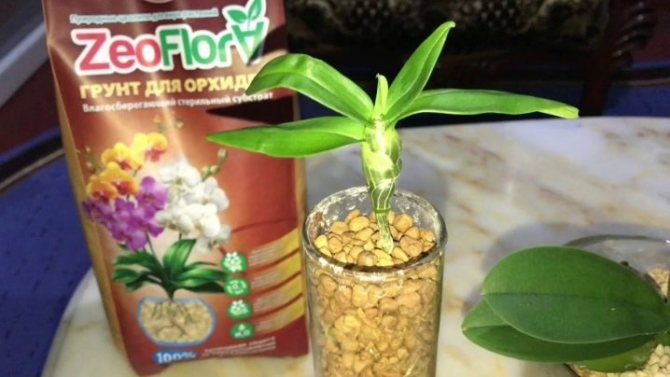

And also it is used as a mulching material that maintains the required level of moisture in the pot.
"Orchiata"
Orchiata is a trade mark that produces high quality natural plant substrate. The main component of these products is specially processed New Zealand pine bark. According to the testimonials of flower growers, large (6-9 mm) porous fractions of pine bark hold water and nutrients well, and their rough surface allows the roots to easily attach and stay in the substrate. According to flower growers, the substrate of this brand is best suited for young orchids with a poorly developing root system.
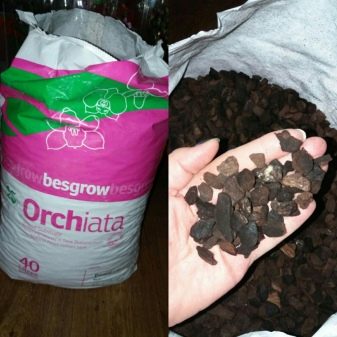

Compo Sana
Compo Sana is a German brand that produces a nourishing moisture-resistant substrate for orchids. This product has a light airy structure that provides unhindered access of oxygen to the roots of exotic plants. The main ingredients of the substrate are pine bark fractions and peat.
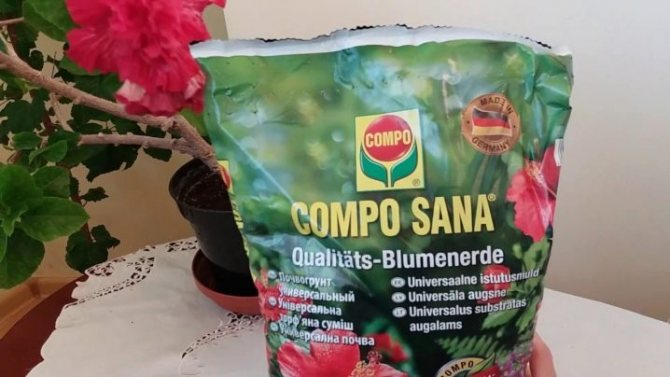

EffectBio
EffectBio is a brand that produces a wide range of substrates and soil conditioners for orchids. The company offers various types of soil mixtures for exotics with fractions of large, medium and small sizes. The composition of the substrates is represented by environmentally friendly and natural components, the main of which is the bark of the Angara pine.
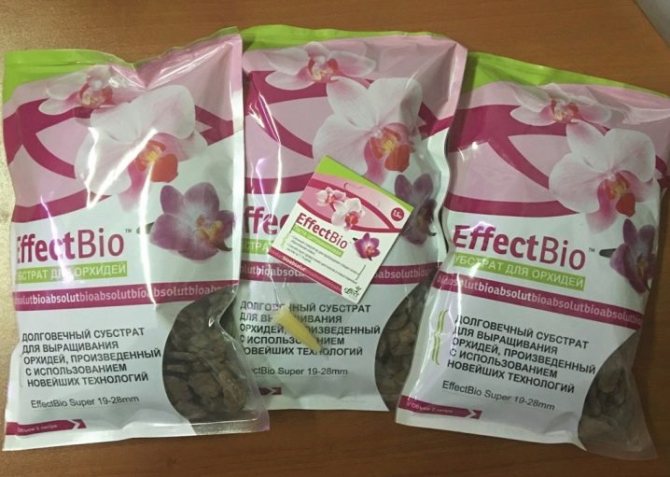

"Fasco"
Fasco is a trade mark that represents a wide range of substrates and soil mixtures for exotic plants. The main component is crushed Angara pine bark, processed in a special way. As additional ingredients, the manufacturer uses high-quality peat, coal, expanded clay fractions.
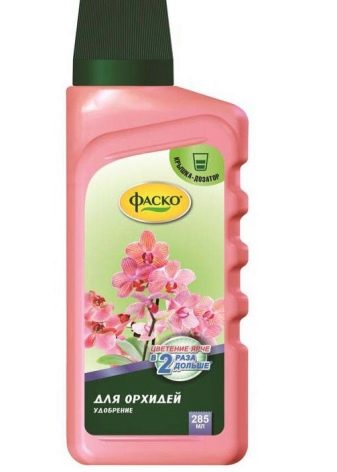

"Seramis"
"Seramis" is a very popular trade mark, the products of which are highly valued by plant breeders. The brand offers orchid substrates made from lightweight porous granules of various sizes.Among the main components used by the manufacturer for the manufacture of substrates are declared: tree bark, branded clay granulate, complex organic and mineral fertilizers.
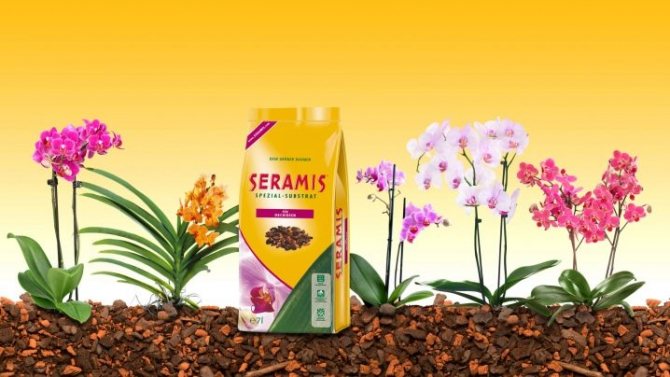

Storage of soil mixture
The finished substrate is subjected to final drying, after which it is packed in paper bags or rag bags and tightly packed. Each component must be prepared in a different container. Store all the components of soil mixtures separately from each other in a well-ventilated area. The soil should be prepared just before planting the plants.
The substrate should be reliably protected from heat and cold, as well as direct sunlight. The most unpretentious to all changes is a coconut product, because its fibers do not absorb moisture, are not afraid of heat and have a long decay period.
Soil for orchids should be:
- dry;
- without smell;
- crumbly.
If the substrate does not meet these criteria, then the ambulance in such cases consists in processing the components with antibacterial compounds of chemical origin. Substrate of inadequate quality must be disposed of. An exception may be expanded clay, which can be heated and dried.
The use of a poor-quality substrate threatens the development of pathogenic flora and the death of the plant. Also, a soil mixture that does not fit the flower in composition is often the reason for the absence of epiphyte flowering.
How to cook with your own hands?
Experienced florists consider the preparation of the substrate at home a rather difficult task. The main problem is the acquisition of base and auxiliary ingredients, which must be environmentally friendly and of high quality. In this case, some components for homemade soil mixture will have to be manually modified. This primarily concerns pine bark and cones, which contain a large amount of resin.
Both the bark and the cones should be heat treated before preparing the mixture, for which the components are boiled for several hours. After digestion, the bark and cones are thoroughly dried and crushed into pieces 1-2 centimeters in size.
Sphagnum, which is the base ingredient, can be purchased at a specialized store. Before preparing the substrate, it should be soaked in water for a couple of hours.
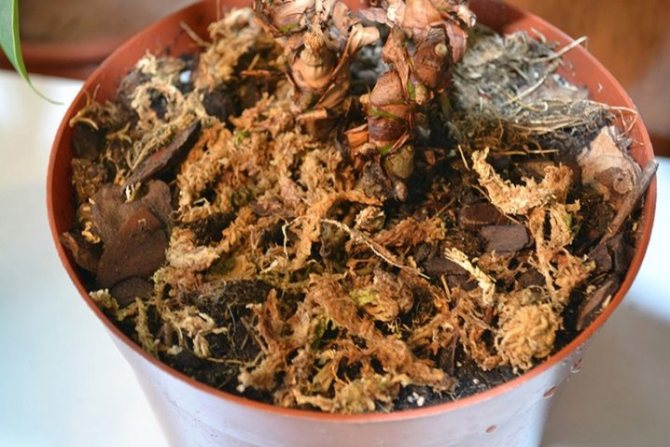

To make the soil mixture for orchids breathable, sphagnum, coarse sand, dry fern roots, coconut fiber, cork material are added to the fractions of the pine bark. To provide additional nutrition for plant roots, it is recommended to add peat and deciduous humus to the mixture.
Clean crushed stone, small pieces of expanded clay or polystyrene are used as drainage.
To make the simplest substrate, you will need to mix bark, sphagnum, peat or fern roots and charcoal. The most popular blend recipe uses ingredients such as:
- 5 pieces of bark;
- 3 parts sphagnum moss;
- 1 part charcoal.
If you have fern roots or peat at hand, the resulting mixture can be supplemented with 1 part of any of the components or 1 part of each.
You can also use such a simple recipe that will allow you to prepare a good substrate for orchids grown in greenhouses. It provides for the preparation of a mixture of pine bark and crushed charcoal, taken in proportions of 5: 1, respectively.
Some growers use the following substrate recipe when the orchid is deficient in nutrients:
- deciduous land - 3 parts;
- crushed pine bark - 1 part;
- crushed charcoal - 1 part.
All components are mixed and 1 part of peat is added to the mixture. The combination of deciduous soil and peat in this case will make it possible to replenish the plant's need for nutrients, and the bark fractions will be able to provide the necessary looseness of the mixture.Coal in this recipe acts as a sorbent and antibacterial component.
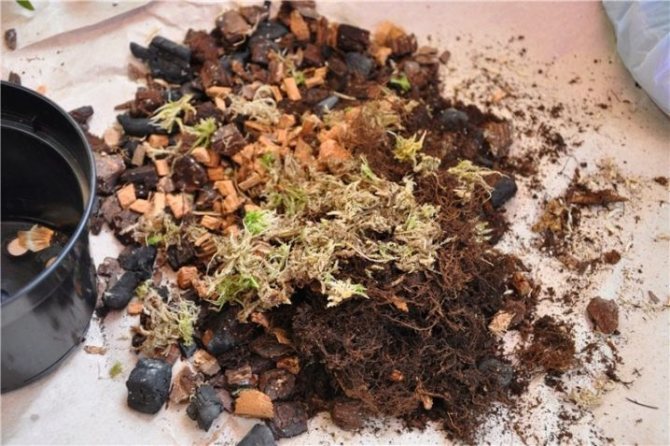

Criteria to be met by the correct composition
What kind of land does an orchid need to transplant? When choosing a substrate, you must pay attention to the following qualities:
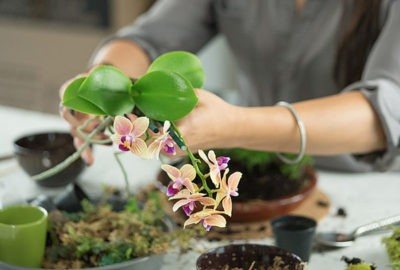

good water permeability;- environmental friendliness, without toxic elements;
- looseness;
- ease;
- optimal acidity;
- breathability;
- complex mineral composition.
Representatives of the Orchid family, which are grown at home, are divided into 2 groups: epiphytic and terrestrial. The difference from each other is not only in the name, appearance, but also in the growing environment. Therefore, substrate for terrestrial and epiphytic orchids is significantly different.
Varieties of epiphytic plants:
- Dendrobium.
- Cattleya.
- Licasts.
- Phalaenopsis.
- Cambria.
- Zygopetalum.
- Masdevallia.
Substrate options: 1 part charcoal and 5 parts bark.
Sphagnum moss, ash and small pieces of pine bark in a ratio of 2: 1: 5. Dry fern roots can be used as additional components, natural leavening agents, drainage.
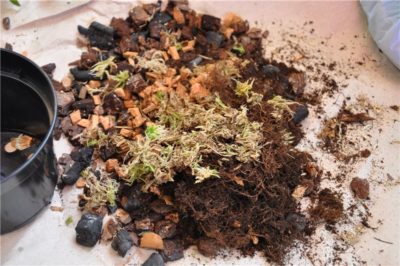

Terrestrial orchids: cymbidium and pafiopedilum. They need increased nutrition. The following soil composition is suitable:
- deciduous humus;
- peat;
- pine bark;
- crushed coal;
- moss.
You can improve the finished mixture a little more by adding sphagnum moss, cork cut into plates and a piece of turf.
Mandatory and additional soil components
The general criteria for choosing a potting mix for indoor orchids are the same. The soil must have the following qualities:
- breathability;
- looseness;
- ease;
- lack of toxic properties;
- have good drainage properties;
- optimal acidity.
In addition, the substrate is renewed every three years, therefore it must be enriched with mineral trace elements. Pine bark, moss, wood ash, fern roots are integral components of the soil mixture for exotic plants. It is this composition of natural materials that is considered the basis for the preparation of the substrate.
Also additional components are added to the main ingredients, no less important, among them:
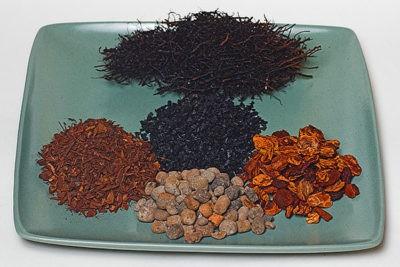

walnut shell;- coconut fiber;
- parts of pine cones;
- humus;
- peat;
- deciduous and coniferous land;
- dry leaves.
Inorganic substances:
- expanded clay granules;
- perlite;
- vermiculite;
- polystyrene;
- mineral wool;
- foam rubber;
- gravel.
These materials are used as drainage.
Block
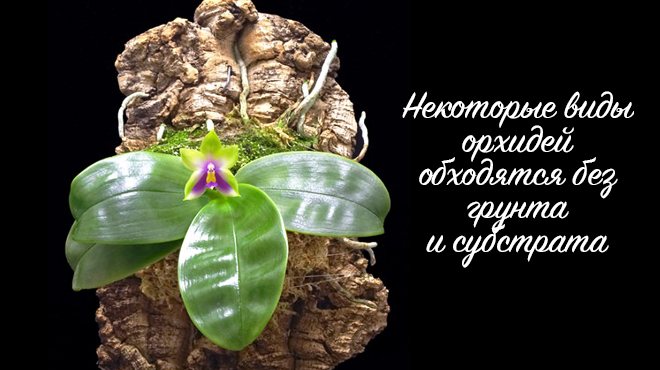

For lithophytic species, that is, representatives of orchids that do not need a substrate and soil in general, landing on a block is provided. The following materials are suitable for creating a block:
- Wood.
- Pine bark.
- Vine of grapes.
A block is formed for disembarkation in the following order:
- First of all, the workpiece is given the desired shape.
- In the middle of the workpiece, a hole is made with a flexible wire for attaching the orchid.
- Marking is carried out, according to which the flower will be installed.
Then the plant is placed on the block so that the leaves hang down. A small amount of moss is laid under the root, and part of the roots is covered with it.
The substrate is used for mature plants and meets all requirements. When self-preparing the soil, a good guide is the ingredients of the soil in which the orchid was sold.
Block landing
One of the options for planting orchids at home is block planting. Here it is important to know which bark is suitable for making a block and how to properly prepare a structure for planting. This planting method is used mainly for monopodial orchids such as vanda or phalaenopsis. The root system of vandas is more suited to outdoor life, but some phalaenopsis simply cannot adapt in pots and grow mainly aerial roots.
To plant on a block, you must choose a massive piece of dead pine tree with bark and be sure to sanitize: boil or bake in the oven. Steam treatment is not suitable here due to the large size of the block.
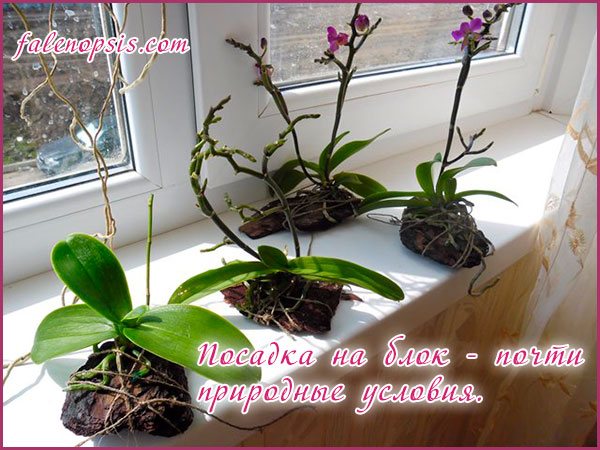

Next, you need to fix the plant with a woolen thread or wire on the block itself, and cover the root system with moss. The plant on the block should be placed in a shaded, light and moderately hot place, since the so-called "soil for orchids" dries quickly enough and requires more frequent moistening.
Another block option is ceramic construction. To do this, you can take a regular unglazed ceramic pot, turn it upside down and put it in a container of water. Attach the plant itself to the bottom of the pot. Fasten the neck and roots with woolen thread or soft wire and cover with moss. After some time, the plant will braid the pot with roots and hold on to it securely. The orchid will receive moisture from the ceramics itself, which in turn will be saturated with liquid from the pallet.
Substrate preparation
How to prepare it at home for an orchid? To create suitable conditions for flower cultivation, you need compose a substrate from the elements necessary for it... Otherwise, the flower may not take root in a new place.
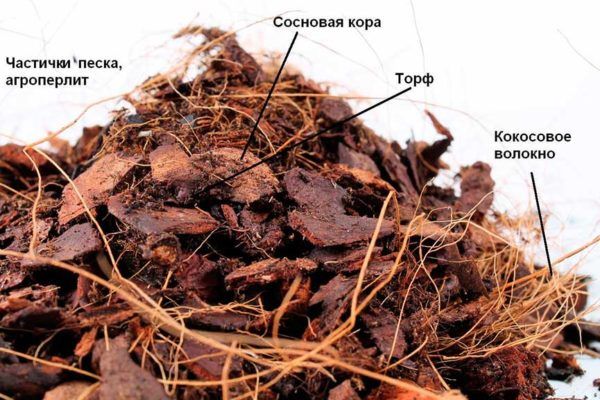

All elements of the substrate are divided into inorganic and organic.
All elements are divided into:
- Inorganic:
- Perlite and vermiculite - These are mineral components that are added to the soil for orchids. They will not give any nutrients to the flower, but will help it cope with rot and mold. In addition, they loosen the soil well;
- Expanded clay - a necessary component, which is placed on the bottom of the pot in a 3 cm layer. This function can be handled by:
- Styrofoam;
- Polystyrene.
- Organic:
- Bark - rip it off from such trees:
- Pine;
- Oak;
- Larch.
- Charcoal - it can be collected after the fire, or you can buy it in the store in the department where the components for going out into nature are sold. It is also available as part of purchased soils and you can select it from there;
- Fern root - it can be dug up in the forest area in the summer. If possible, short pieces;
- Sphagnum moss - it is collected in the forest in swampy areas or along rivers and reservoirs, where there is high humidity.
Soil pest control
Buying low-quality soil or not preparing its components too thoroughly can lead to the appearance of gnats and white bugs in the soil of the orchid. In addition, the appearance of such uninvited guests can provoke excessive watering, because humidity is an ideal indicator for their reproduction. Before starting pest control, it is necessary, first of all, to determine which insects have started up and, in accordance with this, choose methods and preparations.
For example, if fruit flies start up, then no chemicals are needed, they will disappear on their own after the moss is removed from the pot, watering is reduced, and it is made sure that there are no rotten vegetables and fruits in the room.
With sciarids, the situation is somewhat more complicated, but not critical. To prevent their appearance, it is imperative to sterilize the soil, even purchased and even if the packaging indicates that it is sterilized. It is worth contacting a specialized store and purchase a means to combat winged pests, which can be used to process not only the plant, but also the windowsill.
Commercial thrips control products are applied for 10 days, and the plant is washed every 5 days. The soil is watered under running water once a month.
Choosing an orchid pot
An orchid pot is not just a means to highlight the beauty of an indoor flower. A well-chosen pot should be small in size and with side holes. The inside of the flowerpot should be smooth.
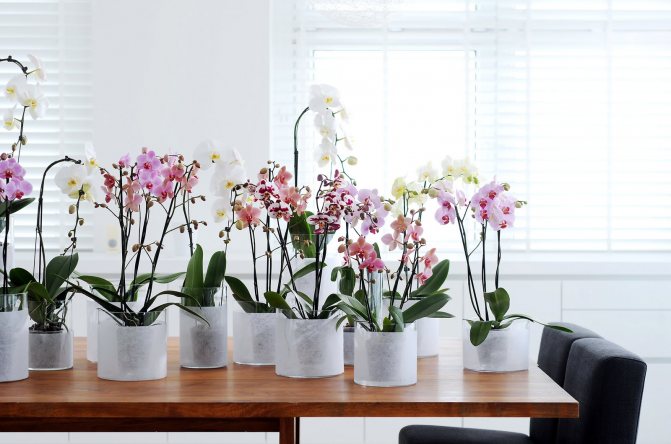

Pot selection
Clay
In stores, you can find a wide variety of clay orchid pots with lots of holes on the sides.
The roughness of the clay inside the pot can lead to ingrowth of roots into the walls of the flowerpot and to the rapid drying of the soil mixture and roots. To avoid this, you need to select glazed clay pots, their surface is slightly smooth.
Clay allows you to maintain the desired temperature for a long time. Before planting an orchid in such a pot, it is worth lowering it in water for a couple of hours. This will enable the pot to be saturated with water, which it will then give to the roots of the flower. If you want to disinfect a clay pot, then it is necessary to put it in the oven for 2 hours at a temperature of 200 ° C before soaking.
Important! Vases made of clay and ceramics should be chosen in light shades. This will exclude overheating of the orchid bark system when exposed to direct sunlight. In such a flowerpot there should be many holes, and not just one, through which all excess water cannot escape.
Plastic
Literally all orchids, except for terrestrial species, are sold in stores in clear plastic shipping pots. The advantages of such flowerpots:
- plastic pots are considered inexpensive and convenient. Through the transparent walls, it is easy to understand whether it is necessary to water the flower;
- the roots of orchids almost do not adhere to the plastic, and if necessary, the orchid can be easily pulled out of the pot for transplanting into another flowerpot or for the purpose of dividing;
- thirdly, the roots of many orchids photosynthesize to the same extent as the leaves, and they need access to sunlight for their normal formation.
If you bought a blooming orchid in a standard transparent plastic pot, do not rush to replant it. In such containers, the flower can grow successfully and bloom well for a long time. If, nevertheless, it is decided to transplant the plant, it is not recommended to take too large a flowerpot, where there is a lot of free space. Otherwise, the orchid will spend energy not on flowering, but so that the root system sooner fills the voids of the flowerpot and is firmly fixed in it.
Well, what kind of soil to choose for planting is described above. It is worth listening to the advice so that the acquired exotic flower does not die after transplantation.
Pros and cons of inorganic substrates
The main components of inorganic soils for exotics are:
- Styrofoam;
- foam rubber;
- mineral wool;
- gravel;
- perlite;
- vermiculite;
- hydrogel;
- expanded clay.
Inorganic compounds have a number of advantages:
- fairly high level of hygroscopicity;
- ease of cleaning from salts that accumulate over time;
- resistance to all kinds of feeding.
However, such substrates also have some disadvantages. The main thing, according to gardeners, is the difficulty of determining the intensity of watering. As a result of these "adjustments" the plant can be significantly damaged.
Popular manufacturers
Each substrate for phalaenopsis or a different type of orchid has its own characteristics, advantages and disadvantages. As mentioned above, pure pine bark is an ideal soil. But quite often you can see perlite in the package, as well as drainage stones, which is not suitable for all orchids. We have prepared a short overview of popular substrates.
Bio effect
The Bio Effect company is quite famous among orchid lovers as a manufacturer of cytokinin paste. However, there is also soil in the product line.
According to the manufacturer, the Effectbio formulation is developed using the latest technologies, the substrate does not need to be sterilized, and it is already saturated with bacteria and microelements that contribute to the growth and flowering of orchids. The base is the bark of the Angara pine, it is quite water-absorbing and suitable for sympodial adult plants and monopodial adolescents.
Ceramis
Seramis is a ceramic substrate with a high moisture capacity.The manufacturer claims that this granulate can be used for all types of indoor plants. As for orchids, it can be used to:
- growing phalaenopsis roots in case of resuscitation;
- planting of monopodial orchid species: dendrobium, cymbidium, cambria;
- increasing the moisture content of the bark when mixing.
Important! Seramis should not be used for permanent phalaenopsis maintenance, as this can have the same effect as if the orchid grows in the ground.
Ceoflora
ZeoFlora Moisture-Conserving Primer for Orchids is one of the most popular substrates for orchids. Due to its porous structure, it provides good aeration of the root system, and the ensured sterility prevents the spread of parasites and diseases. A number of advantages can negate one conditional disadvantage: the fraction of this substrate is very small, it is not suitable in its pure form for planting orchids. Orchid lovers appreciate it quite highly when mixed with ordinary pine bark.
Why is it so important to choose the right soil composition?
When growing tropical crops such as the orchid, one should understand their epiphytic nature. They feed on decaying plants, atmospheric moisture, and sunlight.
The correct soil for orchids is very important, because it will allow the flower to actively grow, develop, bloom for a long time and not be subject to disease. In addition, due to the high-quality composition of the soil, it will not be necessary to apply fertilizers for one to two years before the next plant transplant, since the available components will nourish the root system in sufficient quantities.
Self-cooking
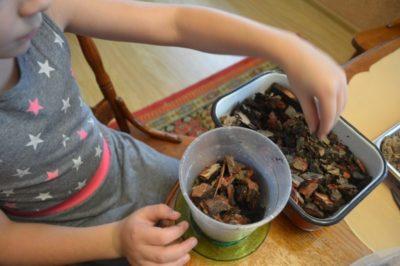

Novice orchid growers exclusively purchase ready-made orchid substrate from garden stores. But experienced gardeners who have been cultivating flowers for more than one year, believe that it is better to prepare the soil yourself. Moreover, self-prepared substrate has a number of advantages:
- low cost;
- proven quality of components;
- simple execution;
- individual selection of components corresponding to the grade;
- drawing up the required proportions.
You can read more about what is better, a ready-made substrate or one prepared on your own, as well as about the composition of the soil, here.
Cultivation of epiphytes in a closed system
Today, many forums and groups are full of photographs of growing orchids in closed systems. What is this system? The options vary, but most often the plant is grown in a glass vase with bark or no soil at all. This method is suitable for certain conditions, as well as for certain species. So, in closed systems, the following can grow:
- wandas;
- mini-phalaenopsis;
- ascocenda.
Since the roots of these species are quite massive, covered with a thick layer of velamen, they need a lot of air and moisture. When planted in a closed system, the use of a fine fraction of the substrate can lead to rotting of the roots and death of the plant. Coconut fiber can be used as a light moisturizer.
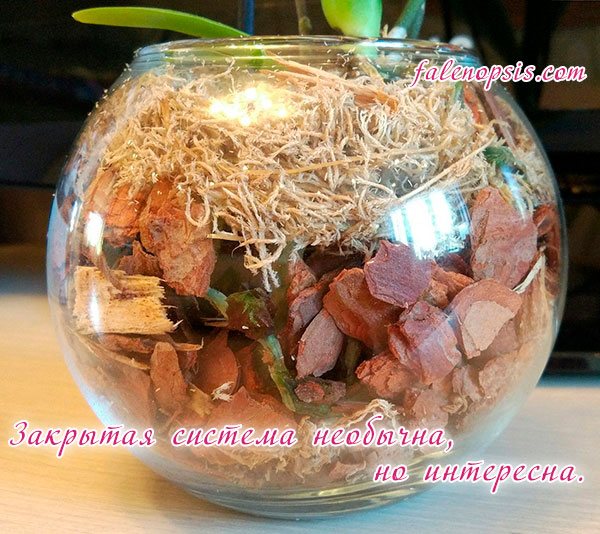

If the conditions allow - the apartment is hot and dry enough, then you can plant mini-phalaenopsis in a closed system with bark. Here it is imperative to mention the drainage of such a system: 2-3 cm of expanded clay is poured onto the bottom, then there is a layer of live moss, and only then can the plant be planted and covered with pine bark of the middle fraction.
As for the content of vanda in a closed system, it is important not to overdo it: do not pour soil into the orchid flowerpot, the effect can be very unpredictable. Despite all the Wands' love for high humidity, she needs excellent aeration inside the tank, and a closed system does not contribute to this. We still recommend growing vandas in classic plastic baskets or hanging.
Pine bark in orchid soil
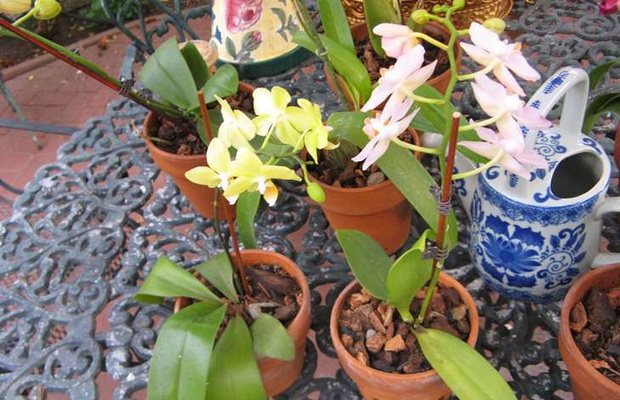

Pine bark (Pinus sylvestris) in Russian conditions, it is accessible and the most technologically advanced, it decomposes more slowly than the bark of most deciduous species (retains its structure for about 3 years), does not emit tannins, like oak bark, it has little resin and it retains moisture well. The main disadvantages of this soil component for orchids are low acidity, low nutrient content and rapid decomposition by microorganisms.
Technological processing of the bark includes washing, soaking, grinding (grinding) and sifting. It is advisable to rinse and soak the bark before grinding so that a suspension of fine sawdust from the dry bark does not get into your breathing nougat.
Also, if you plan to transplant orchids into freshly ground bark, it is best to keep it slightly moist. The bark should be soaked for at least 10-12 hours. During this time, it will be completely saturated with water, it will become softer and it will be easier to grind it. Grinding does not mean grinding the bark into dust, but chopping it into small pieces.
If you know what kind of substrate is needed for orchids, but you need a small amount of soil, you can grind the bark using an ordinary manual meat grinder, from which the knife and net have been removed. In this case, the bark is cut with one screw.
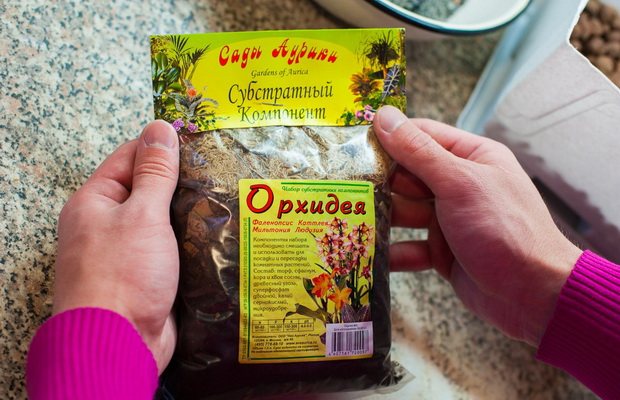

The resulting pieces of bark are heterogeneous, some of them are very small, a lot of crumbs. In order for the substrate from the bark to become homogeneous, it is necessary to sift the resulting mass through a sieve with a mesh size of 7-8 mm.
After sifting, you have a crust with approximately 1 cm pieces that is ready to eat.
If you are afraid to bring eggs of insects, slugs or snails along with the bark, you can boil it twice or scald it with hot water, destroying all organisms that have already settled here. Be prepared for the fact that, after a few days, the boiled bark will be covered with fluff of saprophytic fungi hyphae, which, however, will soon disappear without a trace, without harming your plant.
What does the soil for orchids consist of?
The successful cultivation of plants directly depends on the quality of the soil. Soils for home floriculture must meet certain requirements:
- have the ability to retain water for the root system;
- do not retain moisture in the pot for more than four days;
- not be compressed, it is good to let air through.
Compliance with these classic rules allows you to have beautiful healthy flowers of all kinds all year round. The roots of representatives of the orchid family have a unique ability to store moisture, like an earthen coma in a pot, and then give it to the plant. This property is due to the presence of a velamen layer on them, which has a structure similar to a sponge, and should not be wet for a long time - otherwise it will rot. Velamen cover replaces the earth for orchids, and this is their main difference from all other types of indoor flowers.
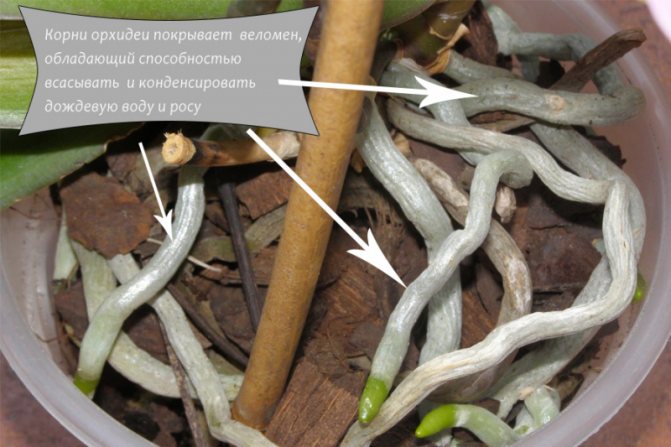

The root system of orchids transfers the accumulated liquid to the plant, remaining dry and able to breathe air, that is, the substrate must dry out as quickly as possible. This is the main condition that the finished soil must meet.
Soil components
A wide range of ready-made soil mixtures for growing orchids is now presented in stores, but it is not always possible to choose a soil for a specific type. It is easy to prepare the necessary substrate with your own hands, the choice of components should be determined not by the nutritional qualities of the components, but by how much the finished mass will be permeable to air, moisture and light. The soil consists of several ingredients, both natural and man-made.
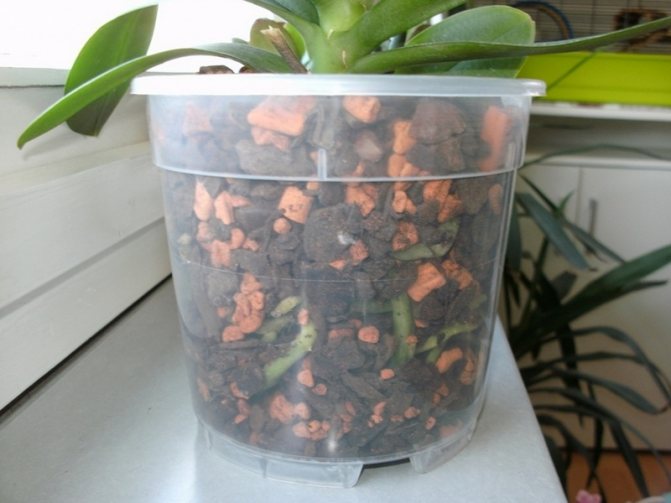

Soil components:
- woody, pine bark;
- sphagnum moss;
- fern roots;
- coal;
- expanded clay;
- polystyrene;
- coconut fiber;
- peat;
- perlite - rock;
- vermiculite is a mineral;
- Pine cones.
Each material fulfills its role. This determines its share in the total volume of the substrate, so that the soil mixture is properly structured and meets the necessary requirements.
Tree bark
The main component of orchid soil is tree bark. She experiences significant stress from moisture and growing roots. Its condition directly affects the quality of the potting mix.
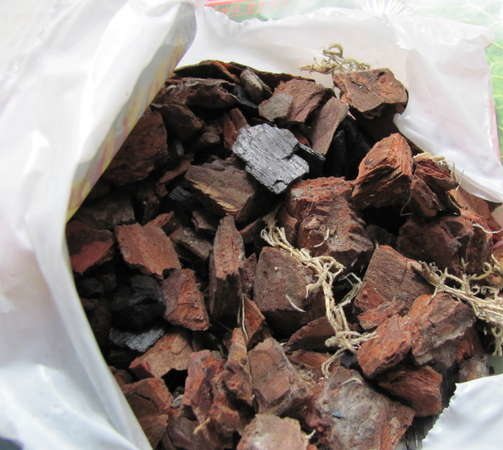

The best option is pine, you can use other conifers. This material is offered by flower shops, but it is easy to prepare it yourself. Collecting is carried out only from dead trees: sawn logs, dead wood or dead wood. The pieces must be taken strong, without mold, traces of rot and massive insect damage. The acquired or harvested bark must be processed as follows:
- boil in water for an hour: to kill eggs and insect larvae and cleanse excess tar;
- cut into plump pieces 2x2 cm in size;
- dry in the oven at 100 degrees.
The material is ready to be sent to the flower pot. To reduce the acidity of the soil, you can add a pinch of dolomite flour to it.
Sphagnum moss and fern roots
Sphagnum marsh moss has a number of properties that create comfortable conditions for the growth of orchids, namely:
- gives looseness to the soil;
- retains moisture without compacting the soil;
- absorbs harmful salts;
- prevents decay.
It can be purchased ready-made, pre-dried and disinfected. When self-harvesting, the collected raw materials must be sorted out, washed, filled with boiling water and squeezed out, dried well. The best time to harvest is late autumn.
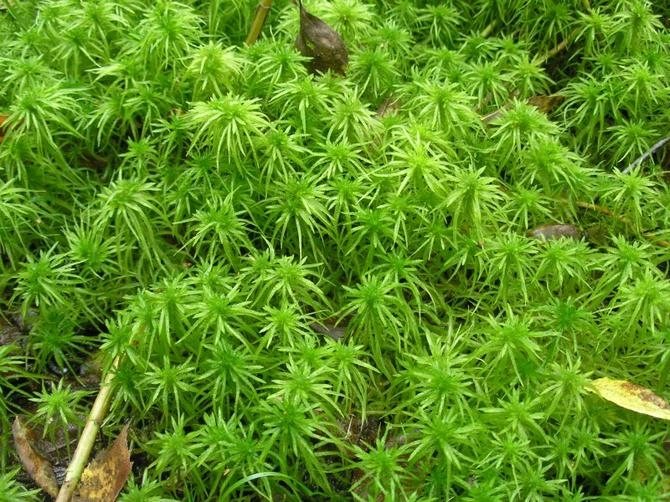

Sphagnum is an ambulance for orchids that die from rotting or drying out of the roots.
Fern rhizomes have properties similar to moss. Before adding to the soil, they are cut into small pieces and processed as described above.
Technical materials
Florists widely use technical materials for soil structuring. These are expanded clay, polystyrene, polystyrene and foam rubber. Expanded clay drainage is indispensable for growing orchids, its main advantage is high hygroscopicity. Charcoal has a similar property, which is also used as a disinfectant and absorbent. It is included in the composition of the soil in pieces of at least two centimeters.
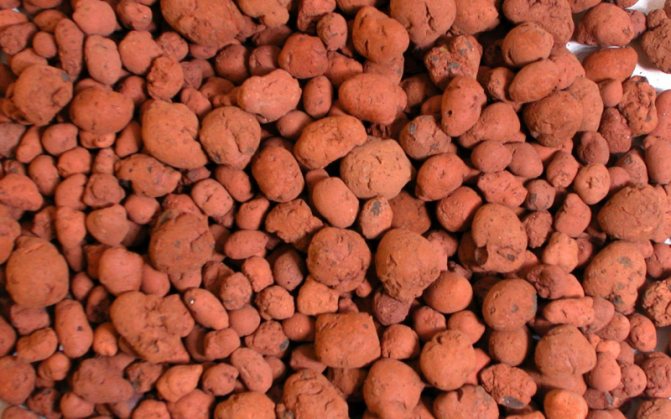

Fragments of synthetic materials - polystyrene, polystyrene and foam rubber very well show their properties in the composition of soil for orchids. Their presence significantly reduces the risks of caking of the soil mixture and increases its air permeability, moreover, they do not emit harmful substances and have a long period of use.
Other soil components
You can add peat, pine cones, coconut fibers, perlite rock and vermiculite to the orchid substrate. All these components increase the looseness of the soil mixture, prevent it from caking and increase air permeability.
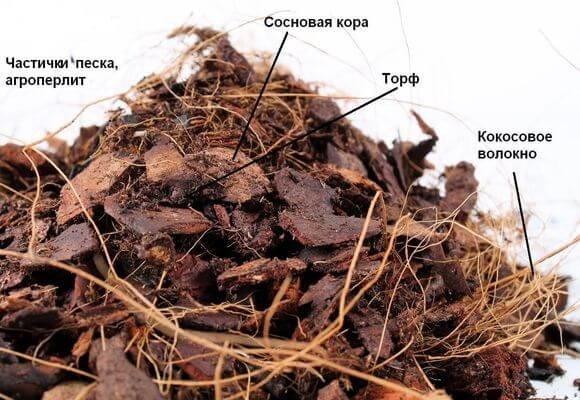

In addition, peat and vermiculite are able to protect plants from mold, fungal infections, harmful insects and retain moisture in the soil. When using peat, it is necessary to take into account its increased acidity; dolomite flour is added to reduce it. All species of the orchid family are epiphytes, so the classic version of the earth for indoor flowers is not suitable for them. The substrate for orchids should consist mainly of whole pieces of pine bark up to three centimeters in size, with the addition of sphagnum and expanded clay.
Important! If midges start in the soil of the orchid, you need to change the contents of the pot!
The composition may include other additional components that increase air permeability and looseness of the soil. The durability of the constituent materials and their dimensions affect the duration of use of the prepared mixture.
How to choose the right finished soil?
The best quality store-bought soil mixtures are:
- "Flower Happiness" by Fasco.
- "Pokon".
- Florin for orchids.
- "OVI".
- "Effect".
In addition to the above, on the market you can find a huge number of different brands of imported and domestic manufacturers. When choosing a soil for epiphytes, you need to pay attention to the composition.
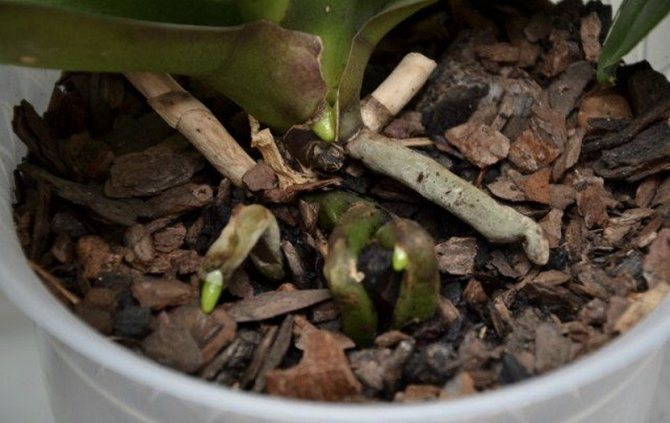

It should contain:
- bark of different fractions;
- perlite;
- antiseptic;
- micro and macro elements.
- Advantages of purchased orchid soil:
- reduction in the time of transfer work;
- no need to carry out work on soil disinfection.
- Disadvantages of a purchased substrate:
- the quality in reality does not always correspond to the declared one;
- often, instead of large fractions of bark, a large amount of wood dust is present in the composition;
- high price.
By self-mixing the components, the grower gets the opportunity to select the necessary components in the required volume and reduce the cost of the soil.
Basic rules for blanks
In order to save the family budget growers collect ingredients for the substrate and stocks for future use:
- The moisture-consuming component - sphagnum moss grows in swampy areas. Used dry and wet. It is recommended to dry the moss in partial shade, pack it in separate bags and store in a dark place. Moss is kept wet in the freezer, in individual packages.
- Coals from the fire should be collected, rinsed thoroughly and chopped to 3-4 cm. Powdered charcoal is used to disinfect plant slices. It is recommended to store in plastic bags in a cool place.
- The pine bark must be dry, but not rotten. It is best to take the bark from a tree that has been cut down for no more than 1 year. Use a pruning shears to chop to a size of 3-4 cm.
- The fern is dug up in the spring before foliage forms or in late autumn when the leaves are already dry. The roots are well dried, cut into pieces. The material is stored in a dark place, in a sealed package.
Important! All ingredients collected in the forest for the future mixture must be sanitized. Cones, wood ash are poured over with boiling water, and then soaked in cool water. Fresh, pine bark is advised to warm up in the oven at a minimum temperature for no more than 5 minutes.
Such a procedure is carried out in order to remove harmful insects, and to increase the ability of moisture absorption.
Watering rules
The best option is to shower or immerse the pot in water until the soil is completely wet. Excess water will drain, and the moistened substrate will provide the flower with moisture for a long time.
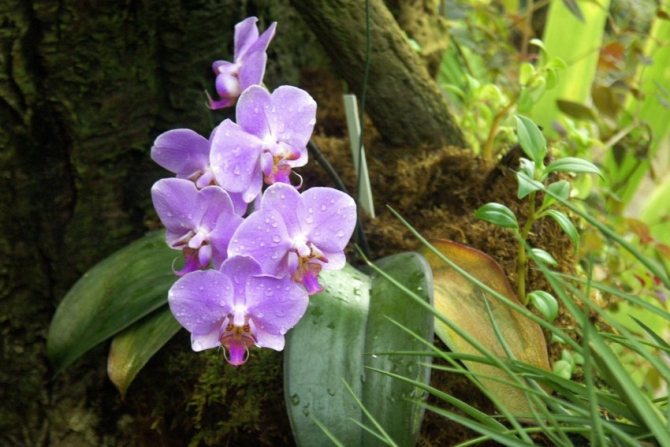

To avoid alkalinization of the soil and rotting of the roots, such manipulations should be carried out only after the soil has completely dried out.
How to replace natural ingredients?
The basis of the substrate for orchids is organic materials. But if necessary, they can be partially replaced with artificial ones.
- Replace the bark with river sand, sheet soil, and foam fragments.
- Moss - polystyrene, foam rubber, hydrogel.
- Add crushed activated carbon instead of ash.
- Use perlite, gravel, brick chips, crushed stone, perlite, cork materials as a drainage layer and baking powder.
Suitable composition and soil requirements
Before transplanting, you need to figure out what the soil should be. What the soil will consist of depends on the nature of the plants. Most orchids are epiphytes. Their roots participate in the process of photosynthesis and accumulate moisture, then giving it to the ground part. In the wild, they settle in crevices in the bark of large trees, but do not receive food from the donor. Such orchids are suitable for soil consisting of oak or coniferous tree bark. A less common type of earthen orchid, it prefers light peat soils covered with moss. For earthen varieties, bark mixed with nutritional supplements and light soil is suitable.
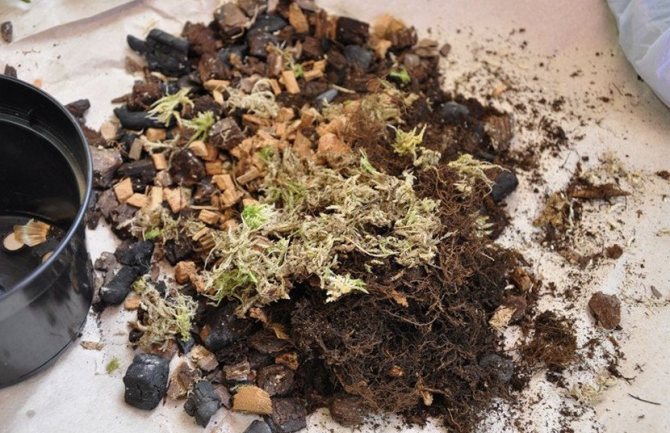

Basic requirements for the composition of the soil for transplanting orchids:
- high hygroscopicity;
- ease;
- the ability to dry within 72 hours after moistening;
- high nutritional value;
- the ability to keep plants upright;
- maximum approximation of the nutritional composition to natural;
- neutral acidity - within 5–7 pH.
Did you know? The reproductive organs of the orchid are similar in color and coloration to those of the insects that pollinate it. Until the bee determines that this is not its relative, the pollen will have time to adhere to its little body and, together with the insect, will be transferred to another flower.
Air humidity
Dendrobium orchid: options for care and reproduction at home
For good growth and flowering, almost all orchid varieties need to maintain optimal moisture levels at the proper level:
- for phalaenopsis 60-80%;
- for the epidendrum 50-75%;
- for cattleya 60-70%;
- for bulbofillum 40-50%.
Note! Moisture values for intrageneric varieties and hybrids can vary significantly. Therefore, the growing conditions for each specific specimen should be clarified before buying an orchid.
Signs that the plant is not doing well due to extremely dry air:
- the edges of the sheets turn yellow and dry;
- buds fall off, slightly blossoming;
- long break between flowering phases;
- the elasticity of the leaves decreases;
- the plant is withering away.
Most of the orchid varieties and hybrids grown in home floriculture adapt very well to room conditions and feel fine with a humidity of 40 to 60%. The problem is that in winter, during the heating season, this figure may drop below 20%. There are several ways to increase humidity in a room:
- buy a humidifier or steam generator;
- grow an orchid in a florarium;
- place an aquarium or a small decorative fountain next to the flower;
- constantly irrigate the space near the flower with a spray bottle;
- put wet, clean towels on batteries;
- install the flowerpot in a pallet with wet filler (moss, expanded clay, pebbles).
Components for different types of orchids
Every kind of orchid needs a certain soil, since some grow epiphytes, others settle in the ground.
Dendrobium
Grow Dendrobium recommended as part of:
- Pine bark - 3 parts;
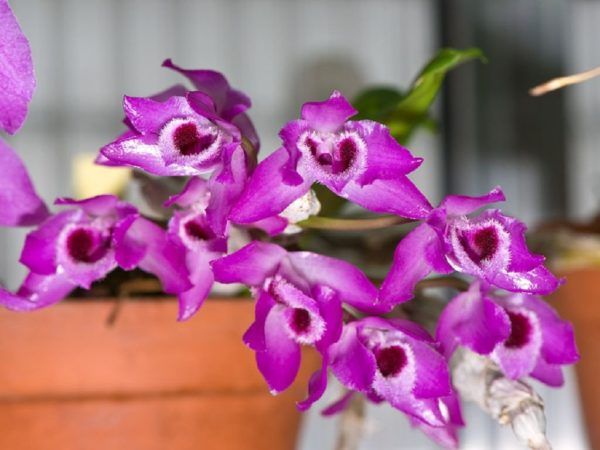

For Dendrobium, as well as for many orchids, pine bark is suitable.
Wanda
To cultivate Wanda you will need more nutritious soil, and therefore, one part at a time must be added to the composition for Dendrobium:
- Sand;
- Peat;
- Perlite;
- And the bark is taken in a small fraction 1x1 cm.
Cattleya
Cattleya grows well in clean bark, but for a certain nutritional value, you can add moss and a little coal, literally 2-3 small pieces per pot.
Miltonia
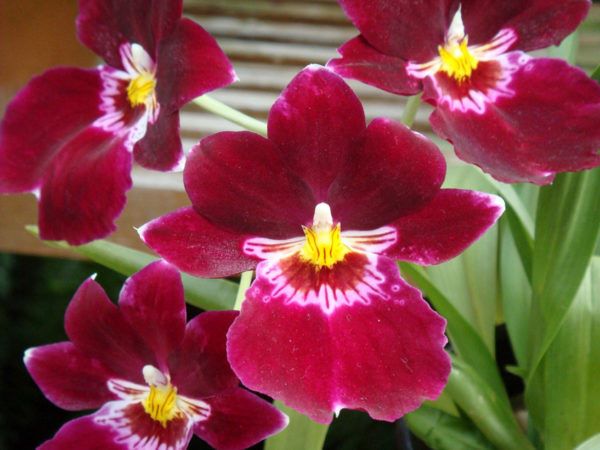

For Miltonia, it is better to mix all the components in equal proportions.
Miltonia needs to take soil, composed in equal shares of:
- Small bark;
- Peat crumbs;
- Sphagnum moss;
- Charcoal.
Phalaenopsis
Phalaenopsis will do composition of the substrate for Dendrobium or you can:
- Plant in one bark;
- And cover the surface of the bark with sphagnum moss.
Outer roots
The thick, spongy, multilayered outgrowths are called aerial roots and are used to extract water from the air or precipitation.
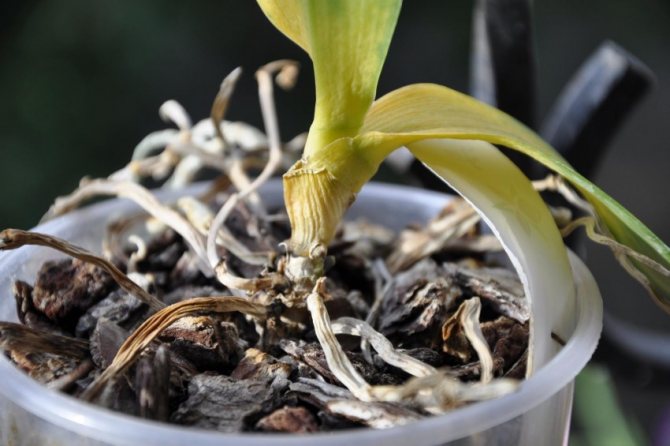

Inside the roots are tubular; through the vessels, water is transported to the rest of the system. During periods of drought, special "capsules" in the roots accumulate moisture and gradually transfer it along the stem to the destination.
Due to velamen, a hygroscopic coating, the roots have a gray, iridescent color. If they get wet, they get a green tint.
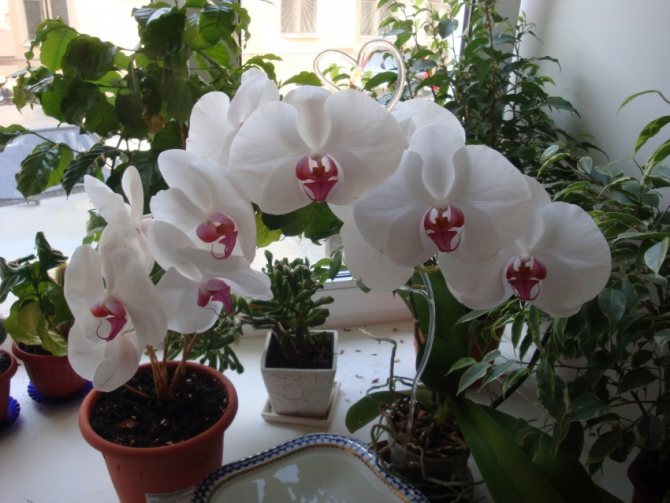

By the color scale of the roots, you can determine the age of the plant, its condition, understand at what stage of development it is. Old processes of a faded gray color, look "dried", the spongy layer is rough and dense.
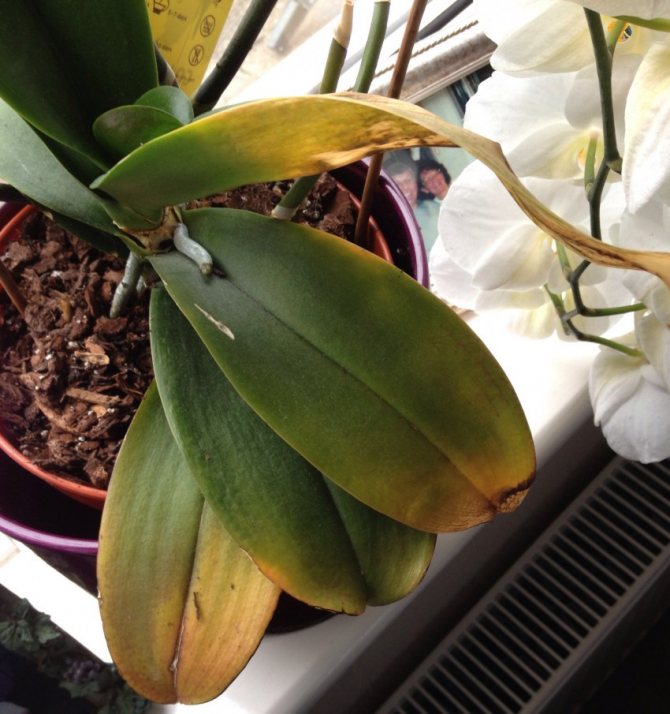

If new, bright green roots are not visible for a long time, it is worth revising the watering schedule and improving care.



